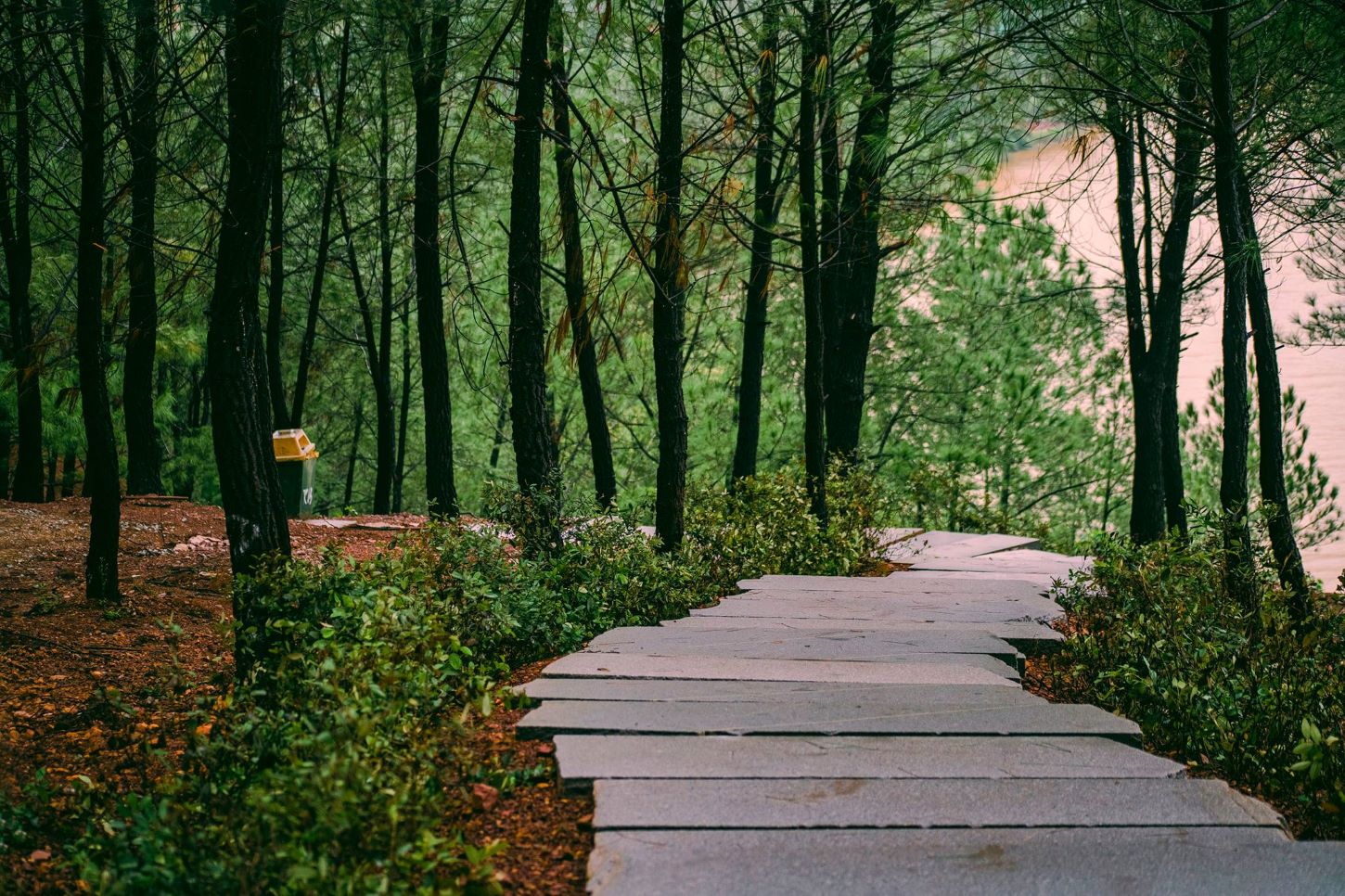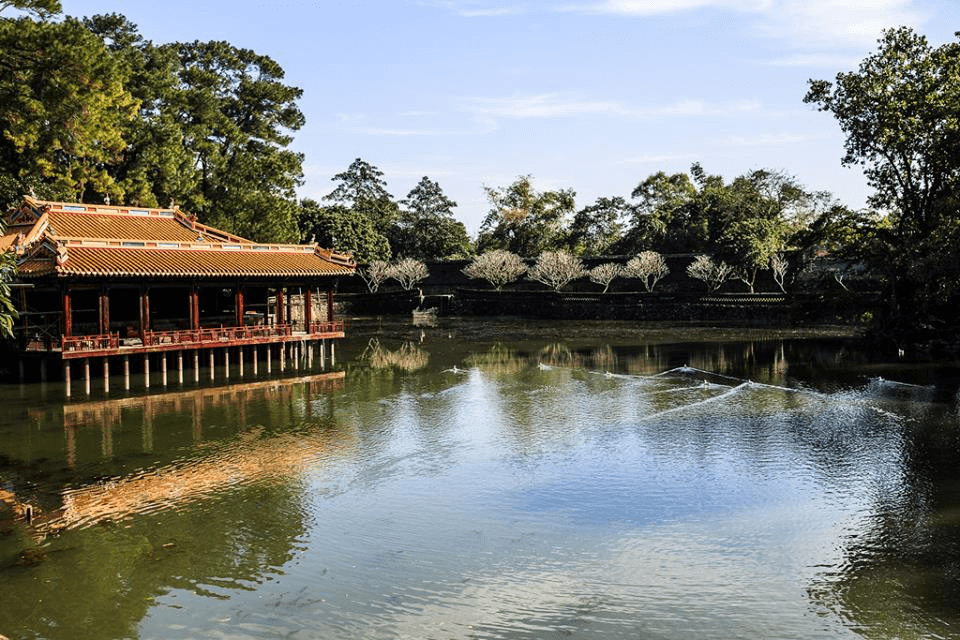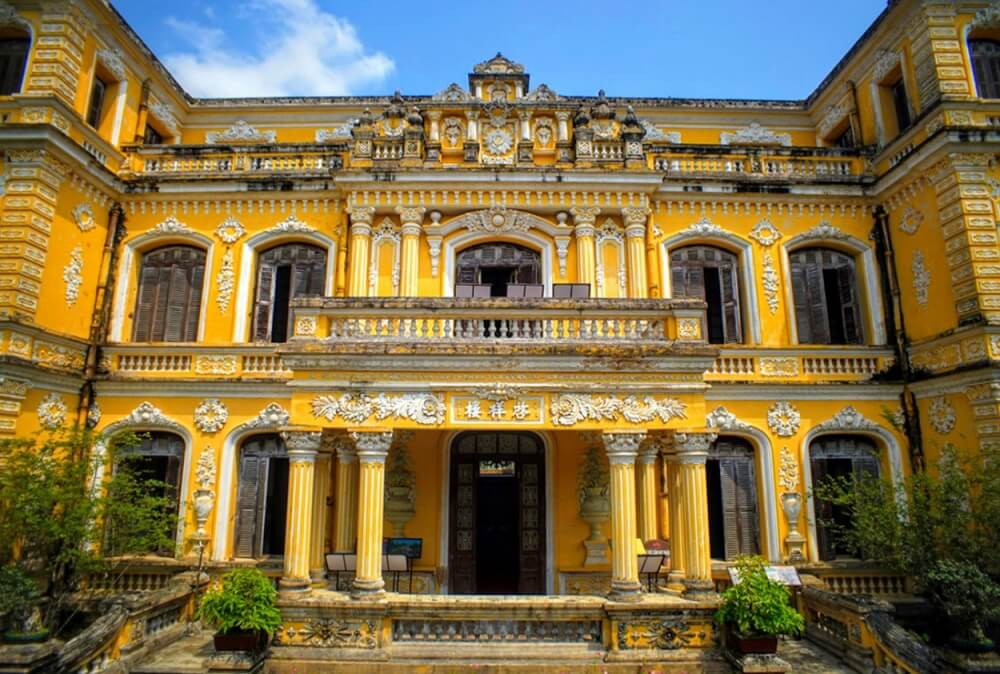Preserving over a century of the Nguyen Dynasty's golden age, Hue Imperial City was once the majestic center of power in the heart of the ancient capital. It is precisely these unique historical and architectural values that earned the site the title of World Cultural Heritage Site, recognized by UNESCO in 1993. Begin your journey back in time in comfort with Queen Cafe Bus right now!
1. Introduction to Hue Imperial City & Essential Information Before Visiting
1.1. Where is the Imperial City of Hue? Location and general scale
The Imperial City of Hue is located in the center of the ancient capital, in Thuan Loc Ward, Thuan Hoa District, Thua Thien Hue City. This is tourist destination Hue The most important site in the Hue Imperial City complex, which was once the administrative, political, and ceremonial center of the Nguyen dynasty—the last feudal dynasty in Vietnamese history. The location of The Imperial City of Hue selected and planned according to Eastern feng shui principles, with mountains behind and facing outwards Perfume River gentle.
The Imperial City of Hue It consists of three main walls: the Capital City, the Imperial City, and the Forbidden City. The Imperial City and the Forbidden City together form an area collectively known as the "Grand Palace." This area was once the place where the Nguyen emperors and royal family held court, conducted administrative affairs, and lived.
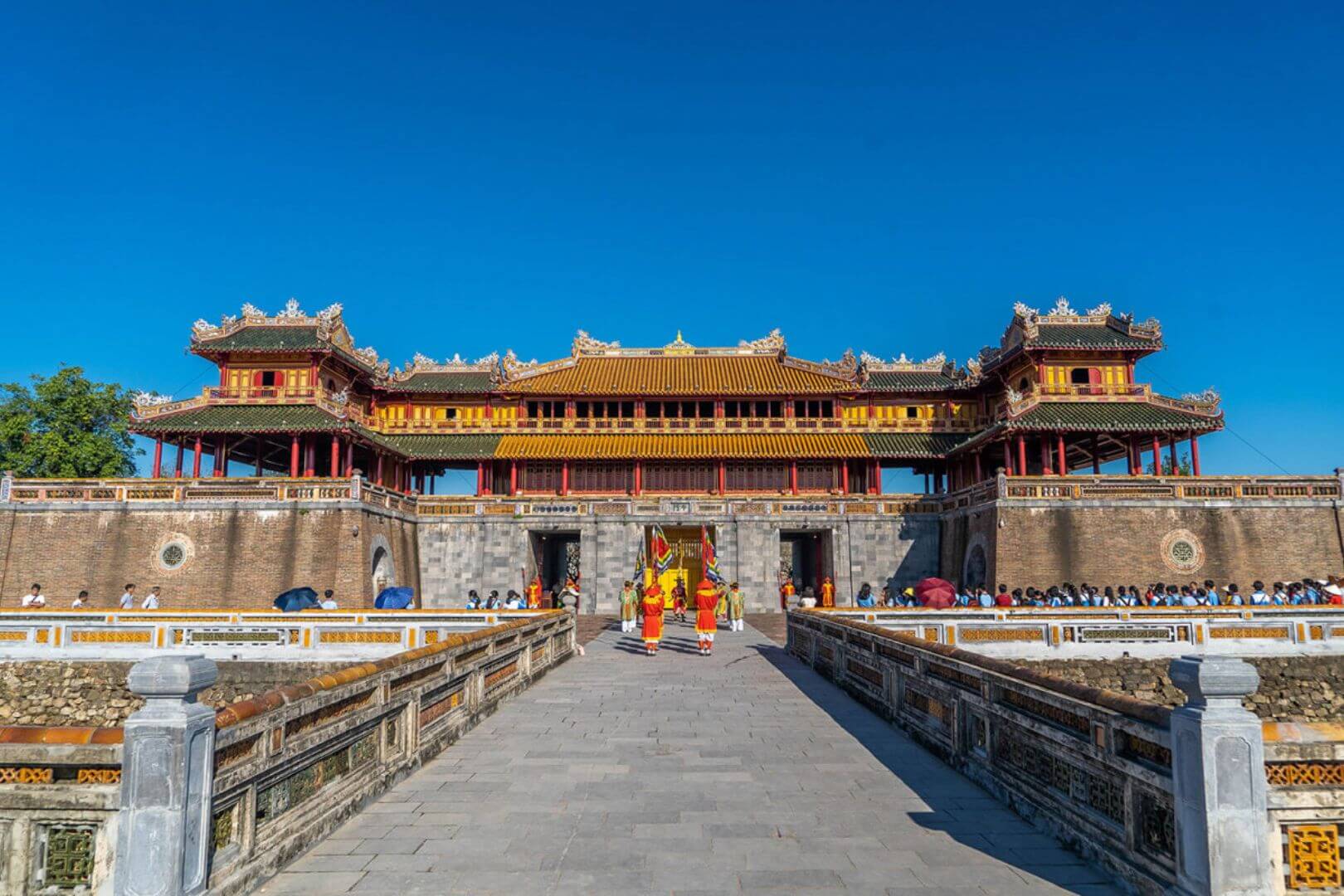
Total area The Imperial City of Hue up to approximately 520 hectares. Surrounding The Imperial City of Hue is a system of fortified walls, approximately 10 km long, with an average height of 6.6 meters and a thickness of 21 meters, featuring 10 main entrances. With an area of The Imperial City of Hue, Inside, there are over 100 large and small structures imbued with traditional imperial architecture, such as the Noon Gate, Thai Hoa Palace, Forbidden City, The Mieu Temple, and Hien Lam Pavilion.

1.2. History of Formation and Major Restoration Phases of the Imperial City of Hue
Imperial City Imperial City of Hue Built in 1804 during the reign of King Gia Long, it was the most important political and ceremonial center of the Nguyen dynasty for over 140 years. Under the reign of King Minh Mang, it was expanded with notable structures such as The Mieu, Hien Lam Cac, Cuu Dinh, etc., reflecting the ideas of feng shui and Confucianism in palace architecture.
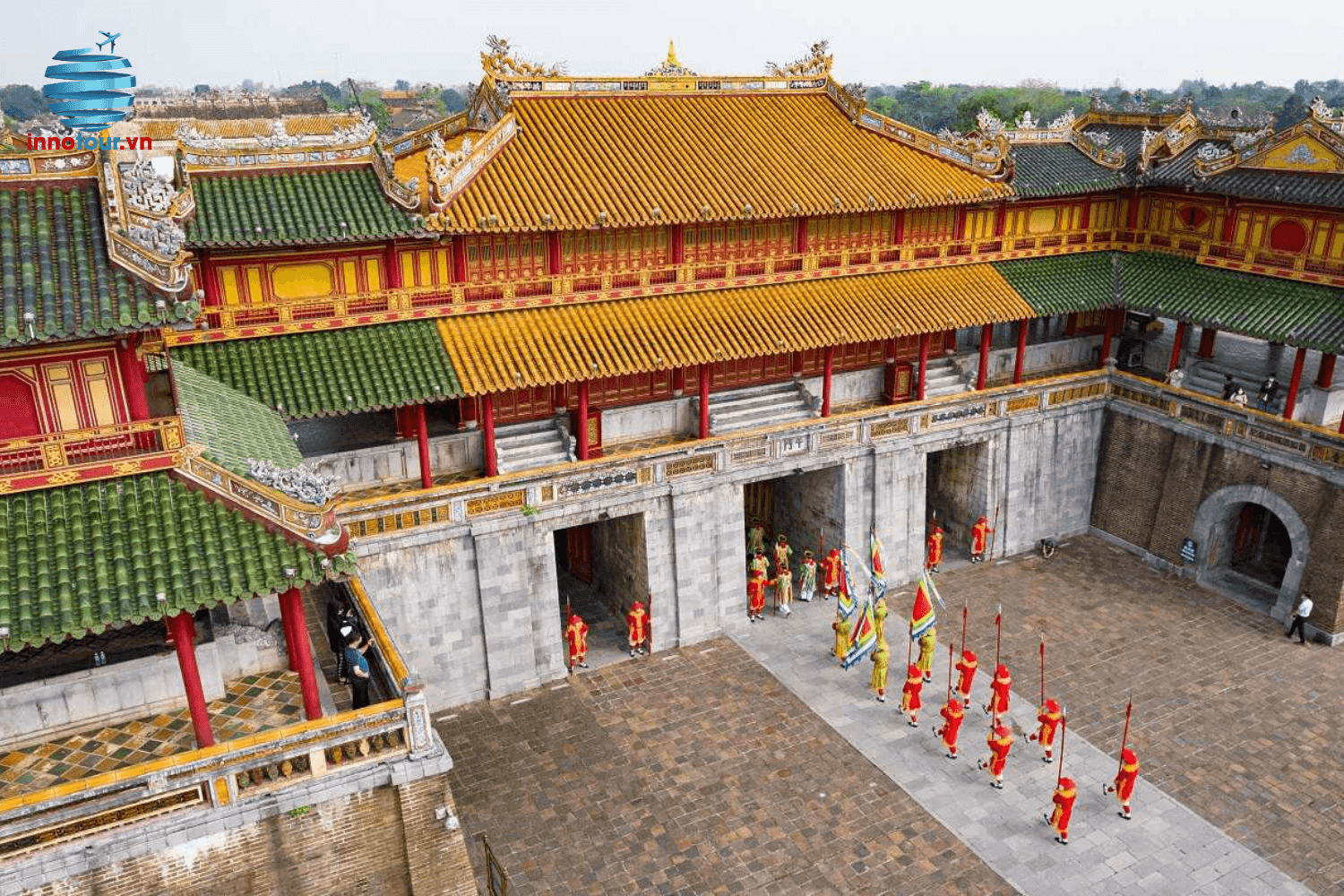
Since the late 19th century, the Imperial City has suffered severe damage due to war and historical upheavals. After being recognized as a World Cultural Heritage Site by UNESCO in 1993, many sections have been restored and reconstructed. Currently, conservation efforts are still ongoing to preserve the precious cultural and historical values of the ancient capital of Hue for future generations.
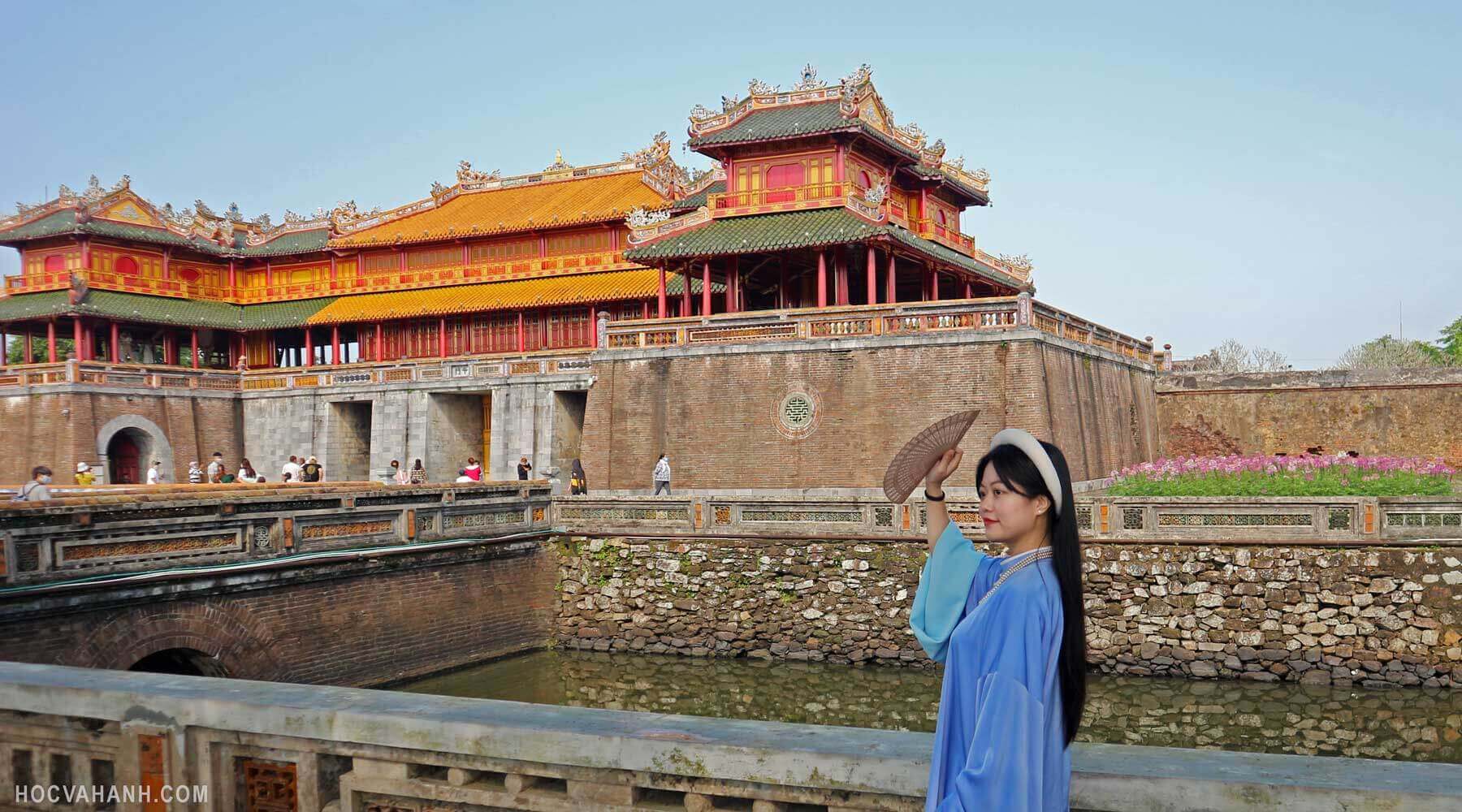
1.3. Opening Hours and Admission Fees for Hue Imperial City 2025 (Updated 2025)
The Imperial City of Hue opening hours:
– From March 16 to October 15 (summer):
+ Opening hours: 6:30 AM – 6:00 PM
+ Ticket sales hours: 6:30 AM – 5:30 PM
– From October 16 to March 15 of the following year (winter):
+ Opening hours: 7:00 AM – 5:30 PM
+ Ticket sales hours: 7:00 AM – 5:00 PM
Admission fee The Imperial City of Hue:
| LOCATION | ADULT | CHILDREN (7-12 YEARS OLD) | CHILDREN <6 YEARS OLD |
| The Imperial City of Hue (Imperial Citadel + Forbidden City) | 200,000 VND | 40,000 VND | Free |
In addition to major landmarks, Hue City also boasts many historical and architectural sites scattered throughout the inner city. Most of these sites are small to medium in size, suitable for short tours lasting 15 to 30 minutes.
| LOCATION | ADULT | CHILDREN (7-12 YEARS OLD) |
| An Dinh Palace | 50,000 VND | Free |
| Hon Chen Power Plant | 50,000 VND | Free |
| Nam Giao Orchestra | 50,000 VND | Free |
| Duc Duc Mausoleum | 50,000 VND | Free |
Pick up some tips for sightseeing The Imperial City of Hue:
- Wear low, comfortable shoes or sandals because you will be walking a lot (large campus).
- Bring a hat, umbrella, and personal water bottle, especially in the summer.
- Early morning or late afternoon has beautiful light, fewer people, and is ideal for photography.
- You should get a map of the Imperial City at the gate or download it beforehand so you don't get lost.
- Visiting the entire Imperial City takes about 4-5 hours if you go thoroughly and combine it with experiences such as Hue court music and dressing up as kings and queens.
2. Map of Hue Imperial City Tour
2.1. Overview of the main areas and sightseeing routes of the Imperial City of Hue
The Imperial City of Hue is meticulously planned according to the principle of the "sacred axis," comprising two main areas: the Imperial City and the Forbidden City. Visitors typically begin their journey from Noon Gate – the main gate and symbol of power of the Nguyen dynasty.
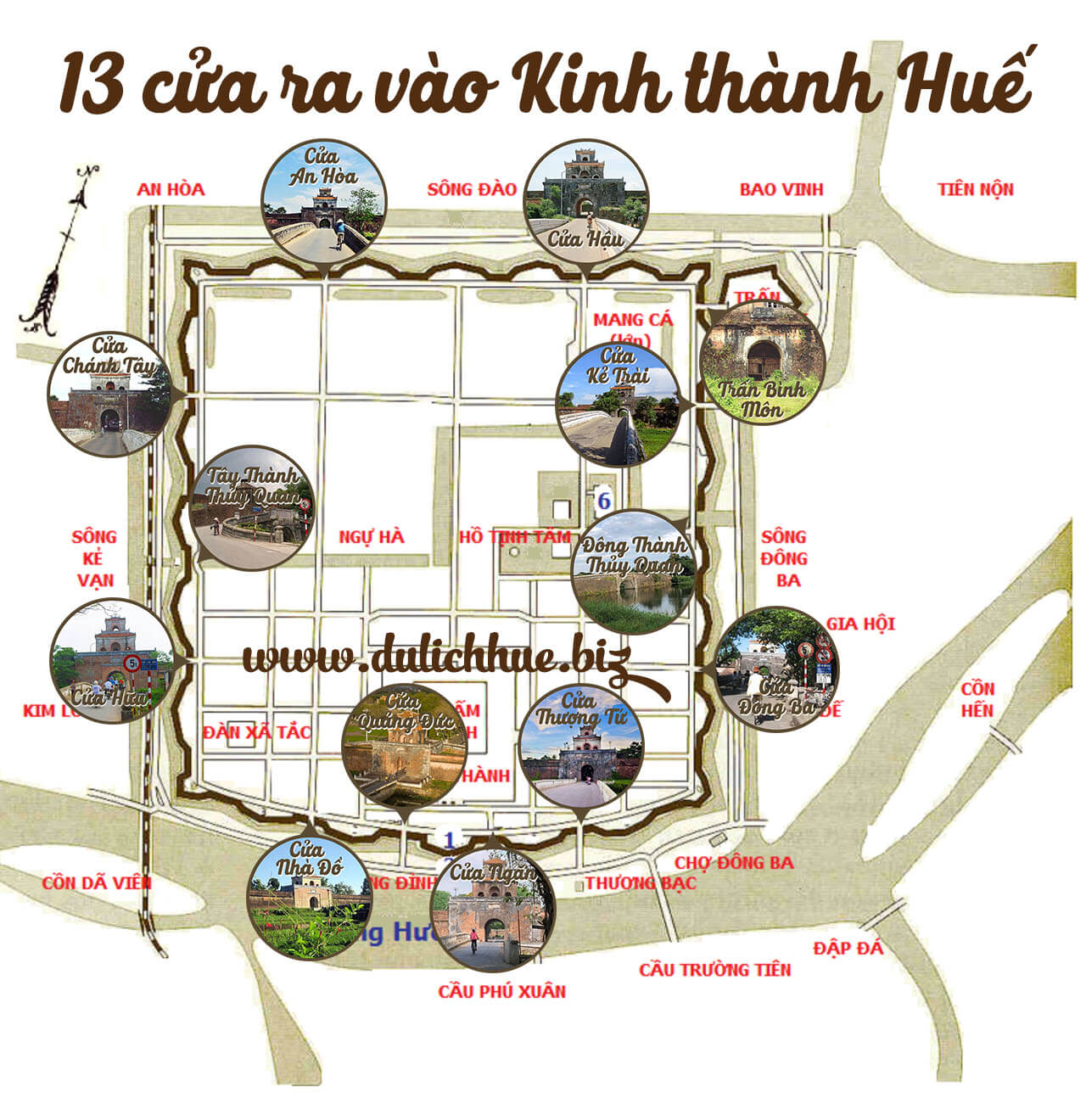
Passing through the No Mon Gate is the vast Grand Ceremonial Court leading to the Thai Hoa Palace, where court sessions and solemn ceremonies of the imperial court were held. Next, the tour route leads into the Forbidden City area—a private space reserved for the emperor and the royal family, featuring many notable structures such as the Can Chanh Palace, the Khon Thai Palace, and the Duyet Thi Hall.
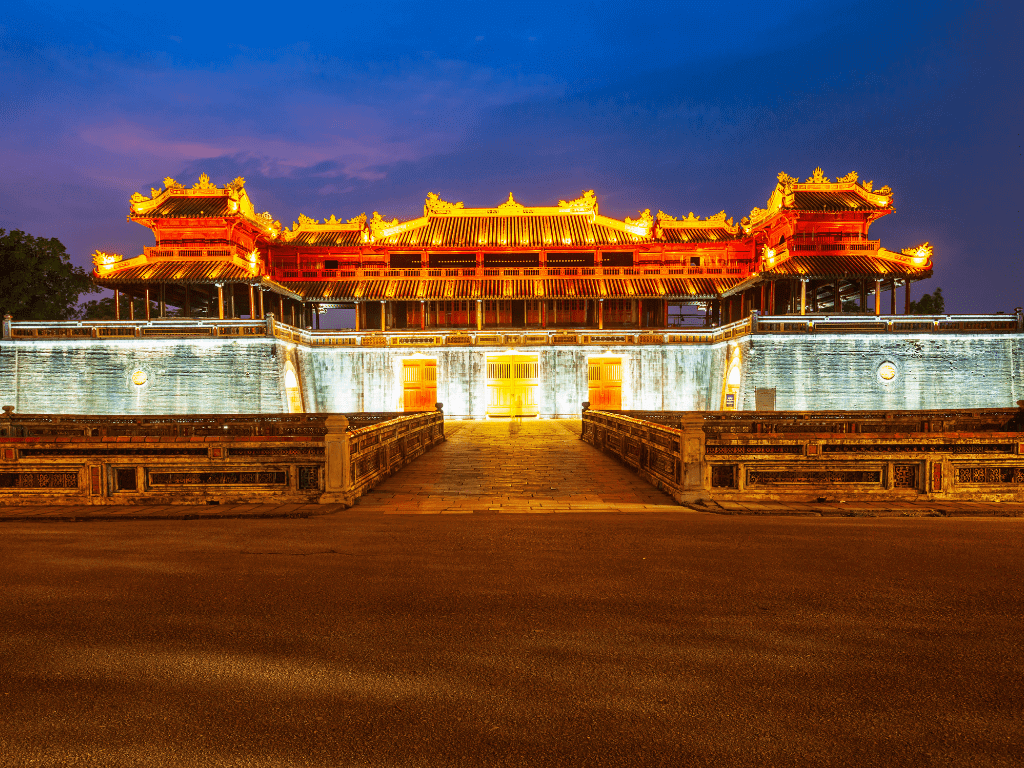
On the left side of the main axis is the The Mieu complex—a place of worship for the Nguyen dynasty kings, along with Hien Lam Cac and Cuu Dinh—structures rich in symbolism and artistic value. At the end of the journey, visitors can stop by the Hue Royal Antiquities Museum to admire the precious artifacts of the former royal family. This tour allows visitors to fully explore the overall structure, power spaces, and distinctive culture of the Nguyen dynasty in a continuous, seamless journey.
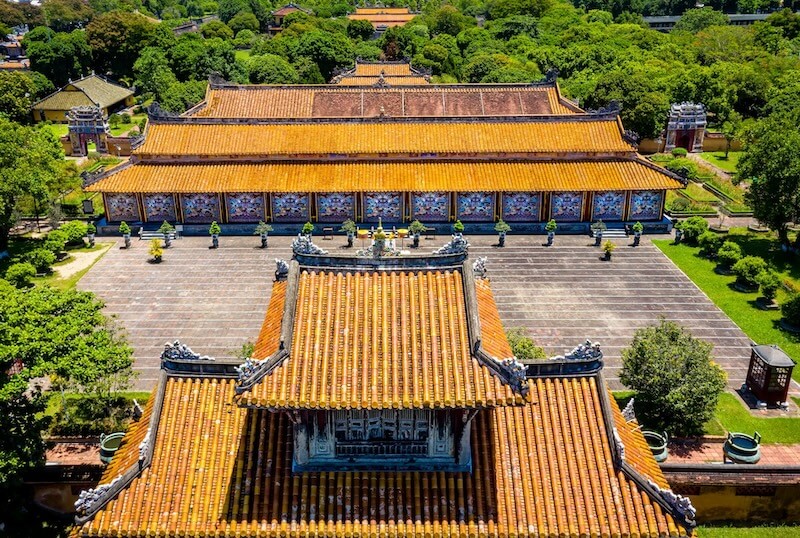
2.2. Suggestions for the best photo spots on the map of the Imperial City of Hue
Not only is it an important historical site, The Imperial City of Hue It is also an ideal check-in spot for those who love photography and ancient architecture. Below are the most popular photo spots among tourists and photographers, helping you capture beautiful moments in the ancient capital.
- Ngọ Môn – Symbol of the Imperial Palace of Hue: Ngọ Môn Gate is the first place you should stop to take photos. The angle from Trung Đạo Bridge looking up at Ngọ Môn Gate will give you a spectacular photo with the majestic imperial architecture. The best time to visit: early morning or late afternoon.
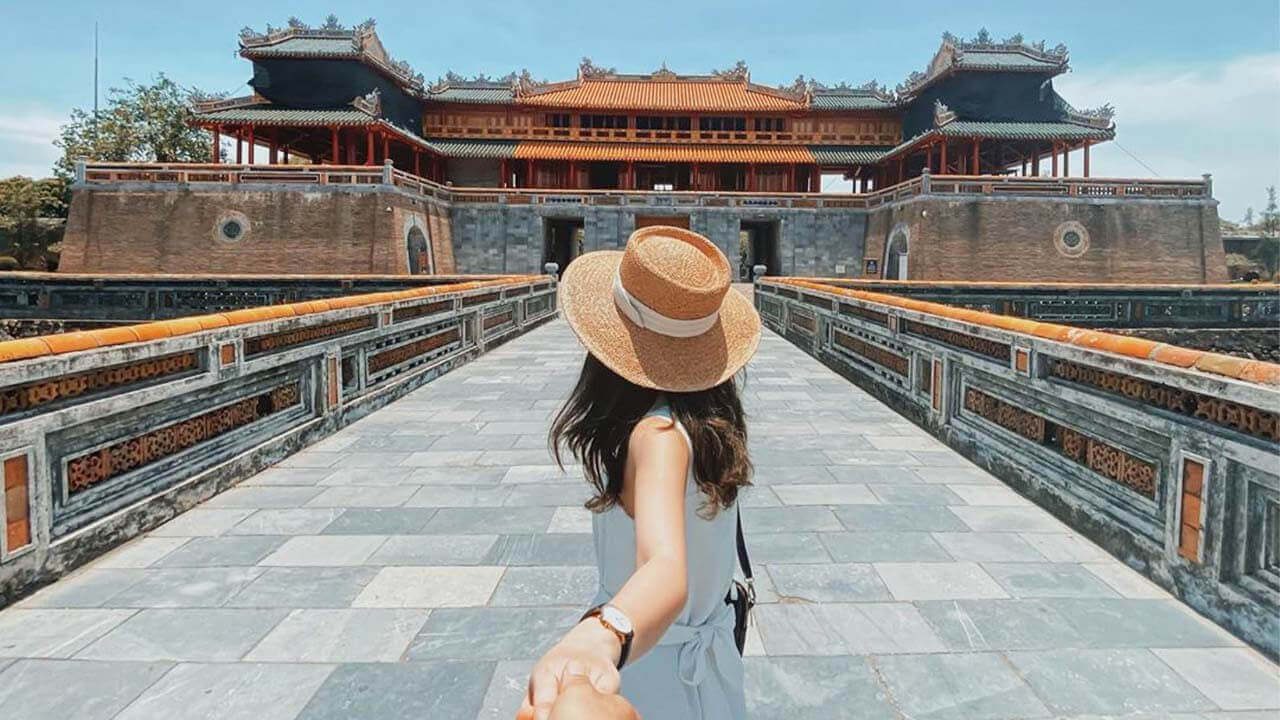
- Grand Ceremonial Ground & Thai Hoa Palace: With its Bat Trang tiles and bright yellow roof tiles, this area offers a regal setting. Standing in the center of the courtyard or taking a photo from the side corridor will allow you to capture the magnificent view of Thai Hoa Palace.
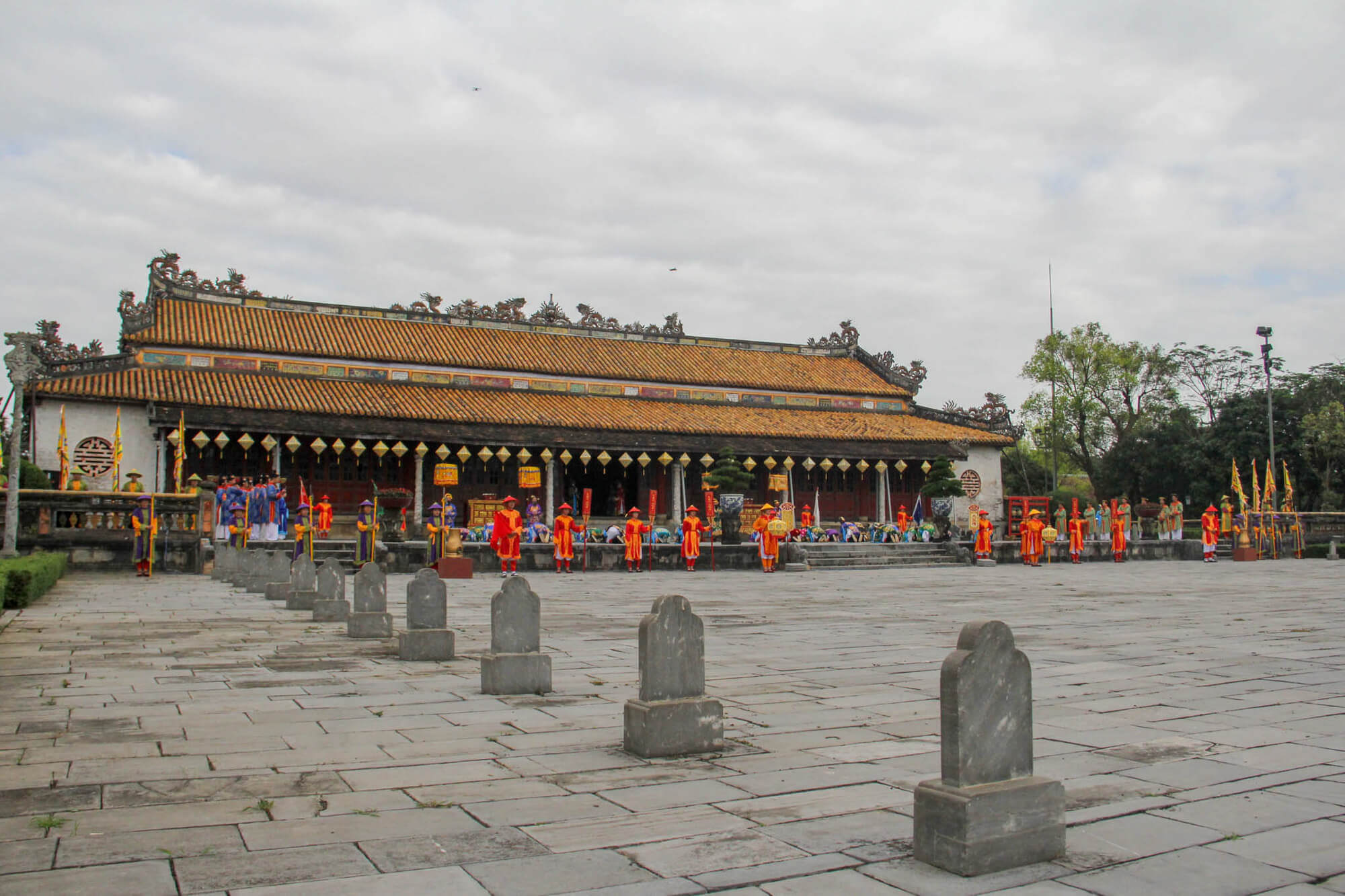
- The Imperial City of Hue – Ancient corridors: The winding red wooden corridors are a distinctive feature of the Forbidden City. You can pose along the corridors to take eye-catching, deep photos with a strong antique feel.

- Duyệt Thị Đường – The Imperial Court Theater Space: With its traditional wooden design and gracefully curved staircase, the ancient Duyệt Thị Đường theater is the ideal setting for artistic photos or photos of people wearing ao dai.
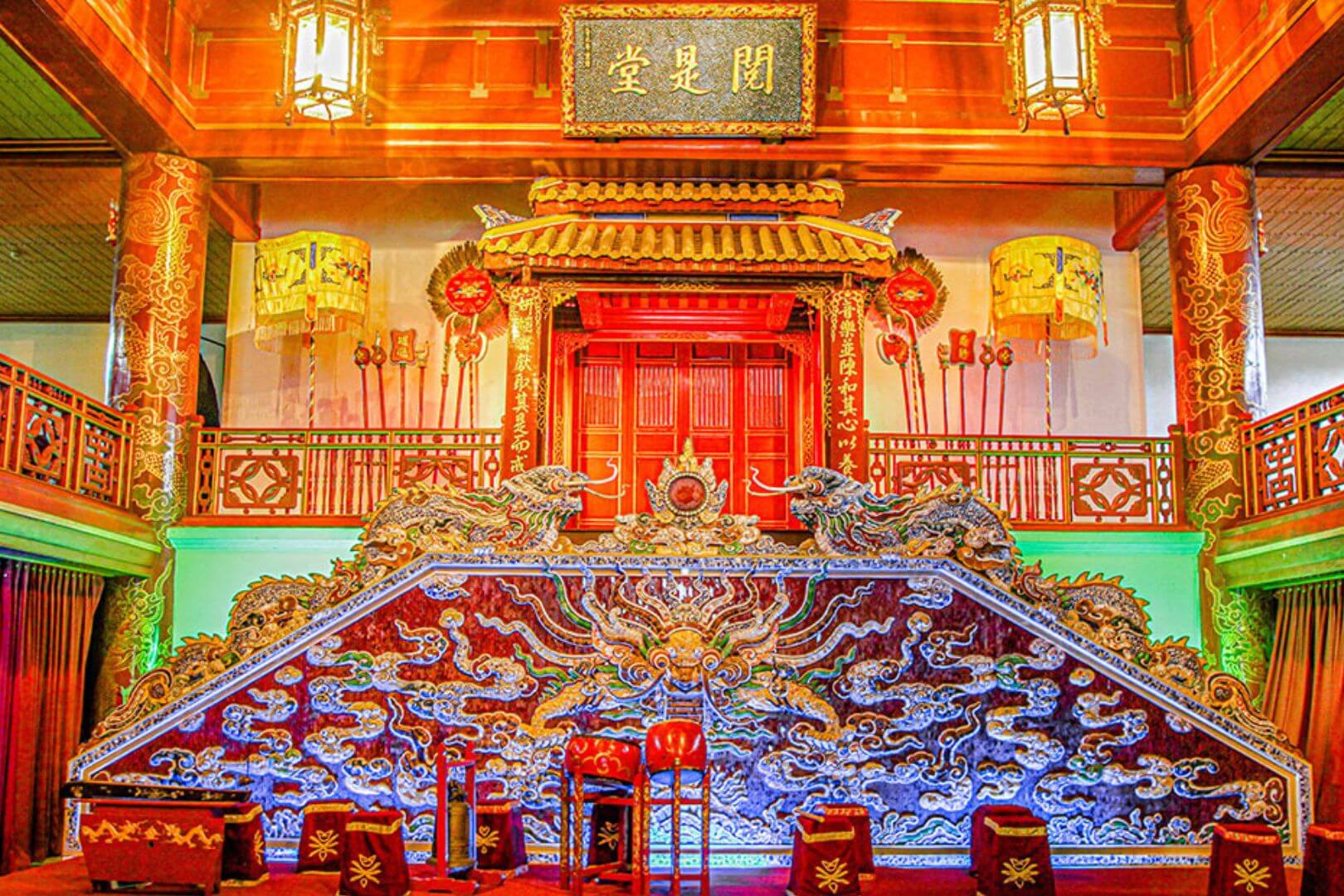
3. Explore the Imperial Palace architecture: What's inside the Imperial City of Hue?
The Imperial City of Hue was the center of power of the Nguyen dynasty, with an architectural layout modeled on three layers of walls: the Capital City – the Imperial City – the Forbidden City. Each area had a distinct function, linked to the activities and rituals of the ancient royal court.
3.1. Outer Circle: Imperial City and Flag Tower (Hue Flagpole)
The Imperial City surrounded the entire palace area. It was built on a large scale, square in shape, with walls nearly 10km long, surrounded by a moat. Standing out on the outer circle was Ky Dai, the national flagpole, where important court ceremonies were held and is now a symbolic check-in point of the ancient capital.
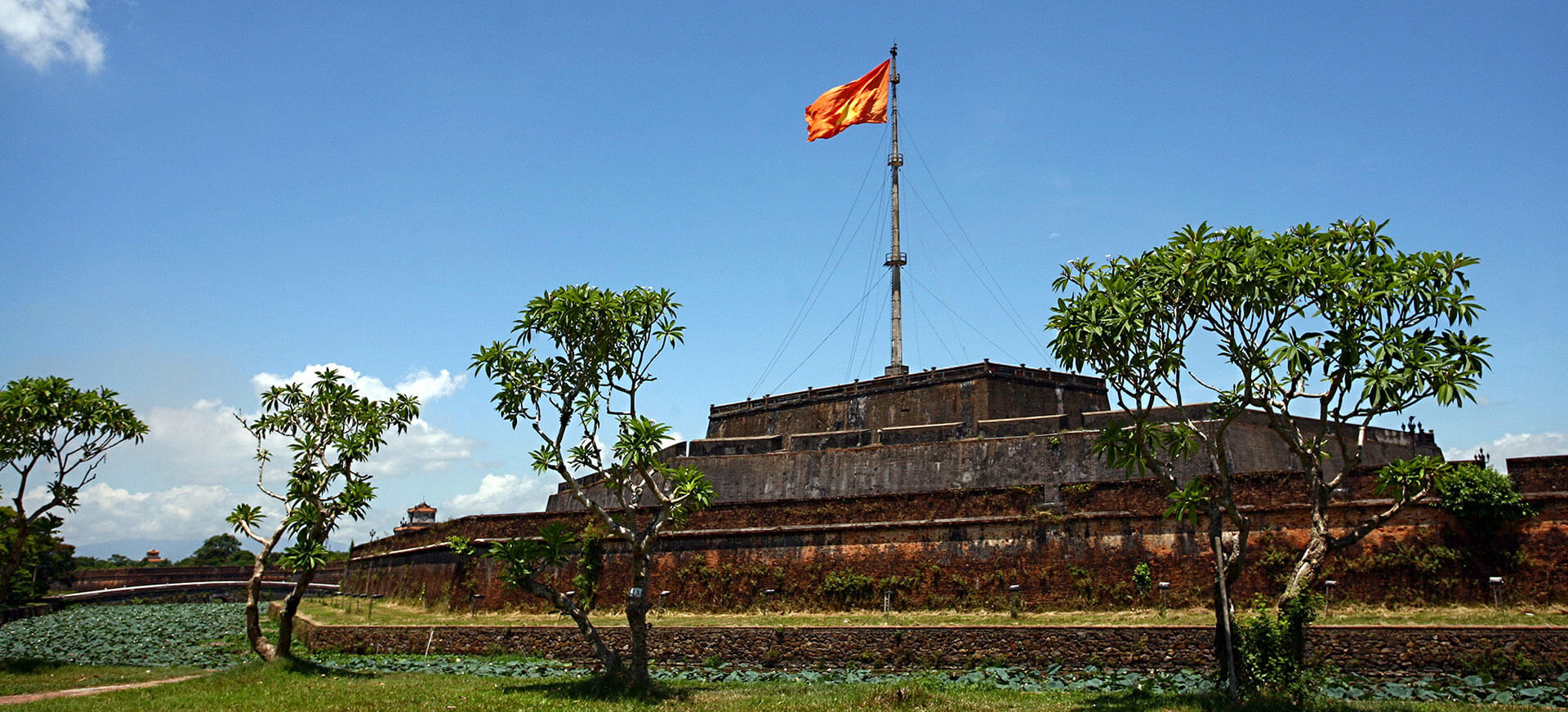
3.2. Middle Circle: Explore the Imperial City area
3.2.1. Ngo Mon Gate
Ngọ Môn is the main southern gate leading into the Imperial City, considered a symbol of the power of the Nguyen dynasty kings. The structure is U-shaped, with a base built of Thanh stone and topped by the Ngũ Phụng pavilion with a golden tiled roof featuring exquisite carvings. Only the emperor was permitted to pass through the central passage of Ngọ Môn, while officials, soldiers, and royal family members used the side passages. This was the site for ceremonies welcoming envoys, announcing royal decrees, and where Emperor Bảo Đại declared his abdication in 1945—a milestone marking the end of the feudal regime in Vietnam.
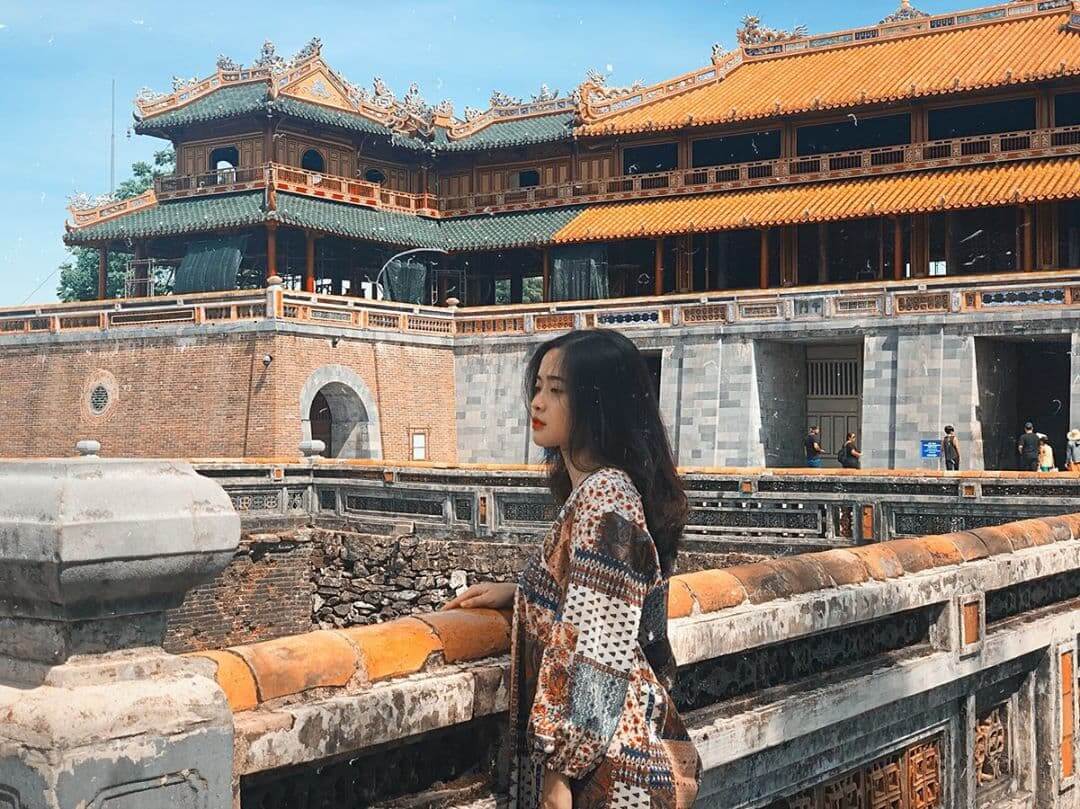
3.2.2. Thai Hoa Palace and Dai Trieu Nghi Grounds
Following Ngọ Môn is the Grand Audience Court, where grand audiences were held on the fifteenth day of the lunar month, the first day of the month, or during major festivals. At the end of the courtyard is Thai Hoa Palace – where the most important ceremonies such as coronations, court sessions, and receiving foreign envoys took place. The palace was built on a high foundation, covered with yellow glazed tiles, decorated inside with dragon motifs and lim wood pillars painted red and gilded with gold. With its magnificent architecture and vast space, this place clearly reflected the dignity and standards of the Nguyen dynasty.
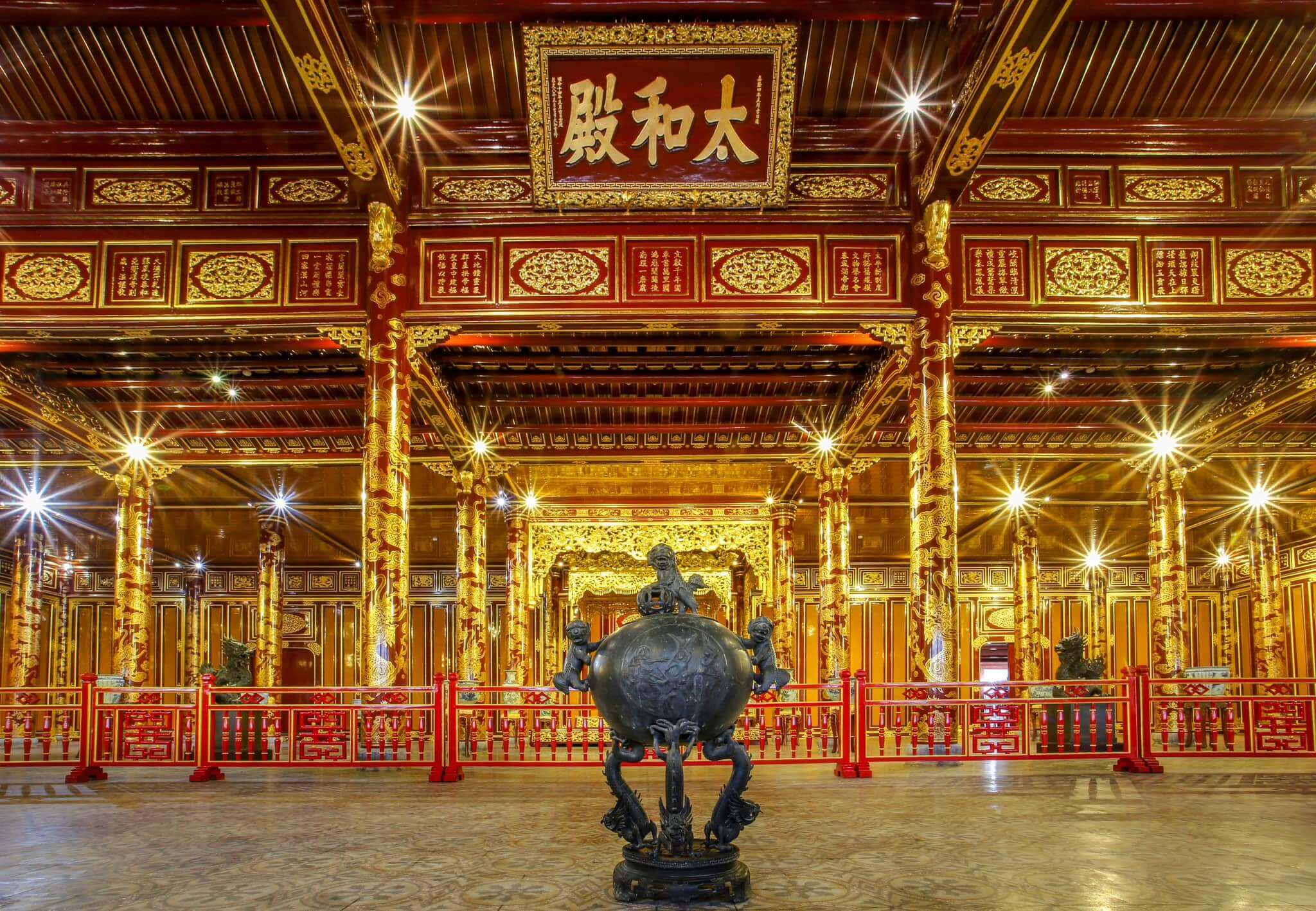
3.2.3. The Temple of the Founding Emperor – The Hall of Illustrious Forest – The Nine Tripods
Turning left from the main axis is the The Mieu area, where the Nguyen emperors are worshipped. It was built during the Minh Mang era to honor ancestors and strengthen loyalty to the throne. Opposite is Hien Lam Cac – a three-story structure that honors the achievements of virtuous ministers and renowned generals. In front is Cửu Đỉnh – nine large bronze tripods symbolizing the nine Nguyen emperors from Gia Long to Khải Định. Each tripod is engraved with symbols of the country's nature, culture, and geography, carrying both symbolic meaning and demonstrating the Nguyen dynasty's high level of bronze casting.
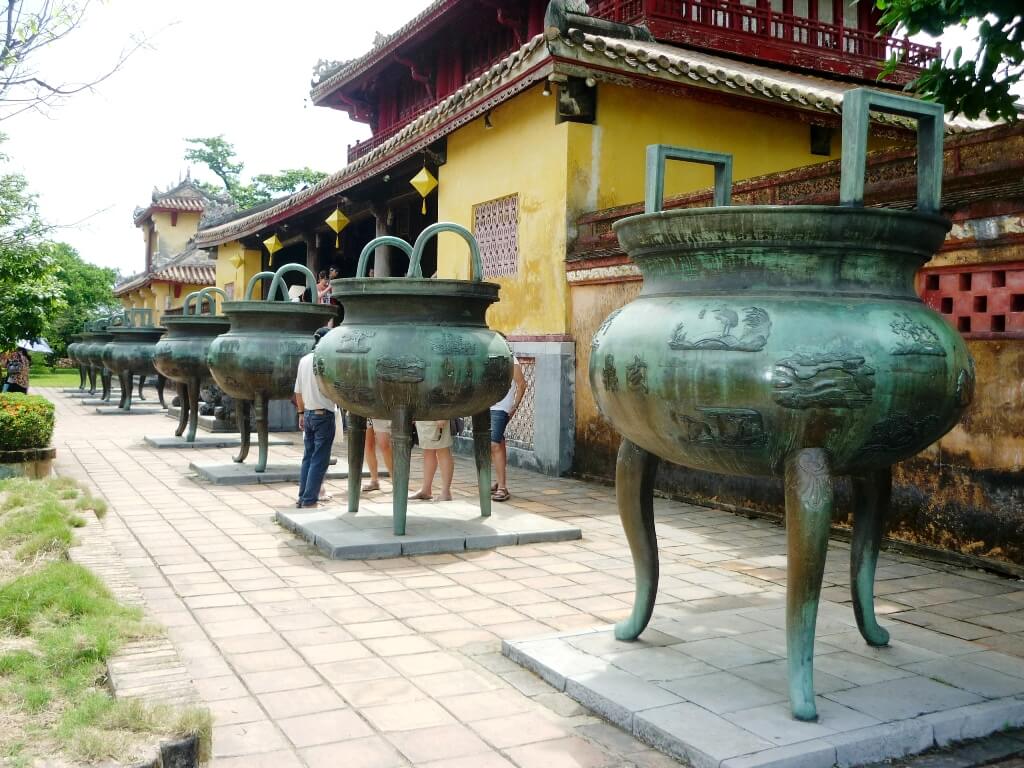
3.2.4. The Palace of Longevity and the Palace of Eternal Life
Dien Tho Palace was the residence of the Empress Dowager, the king's mother. Its architecture is both elegant and discreet, reflecting the noble role of the most powerful woman in the royal court. The palace consists of many interconnected rooms linked by corridors, designed to harmonize with the natural landscape. Behind it is Trường Sanh Palace – a place of rest and meditation for the Empress Dowager and the older concubines. Both palaces reflect the gentle, profound nature of court life.
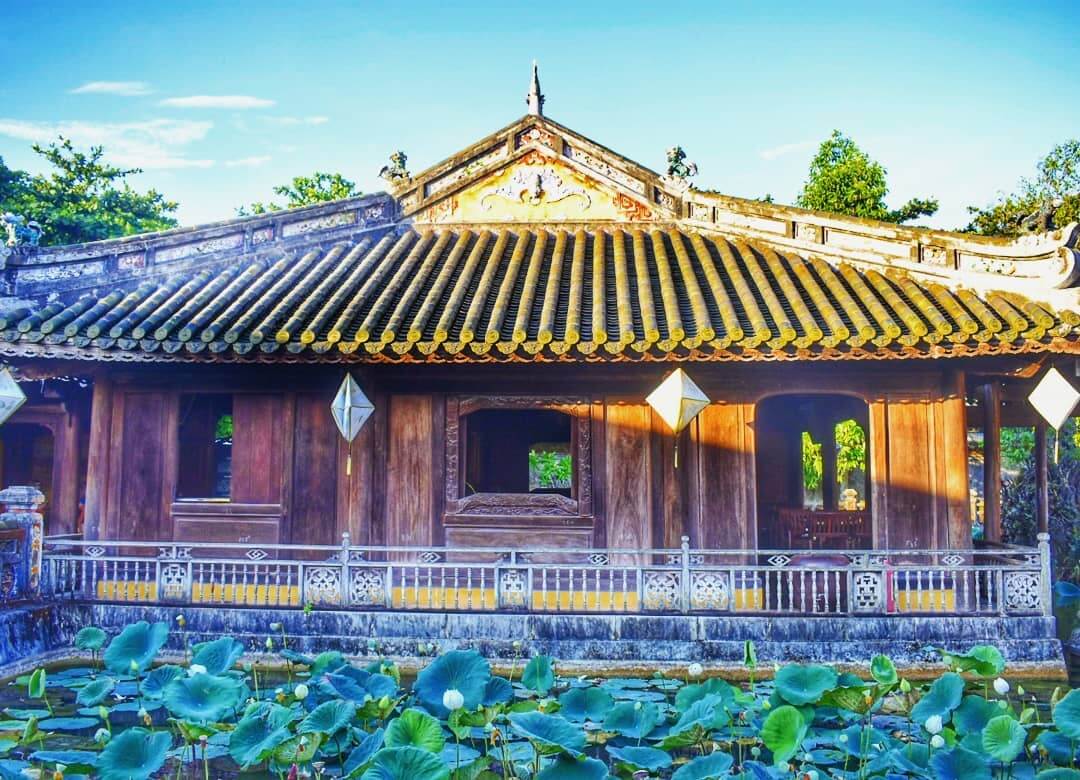
3.3. Innermost Circle: Explore the Forbidden City of Hue
The Forbidden City was the most private and secluded place in the entire imperial palace – reserved only for the emperor and those with special permission. It included areas for work, rest, entertainment, and the emperor's daily life.
3.3.1. Great Palace Gate
This is the main gate leading into the Forbidden City, clearly separating the official space from the inner palace. The Grand Palace Gate has a modest but refined architecture, marking the highest boundary of power—only those permitted by the emperor were allowed to pass through.
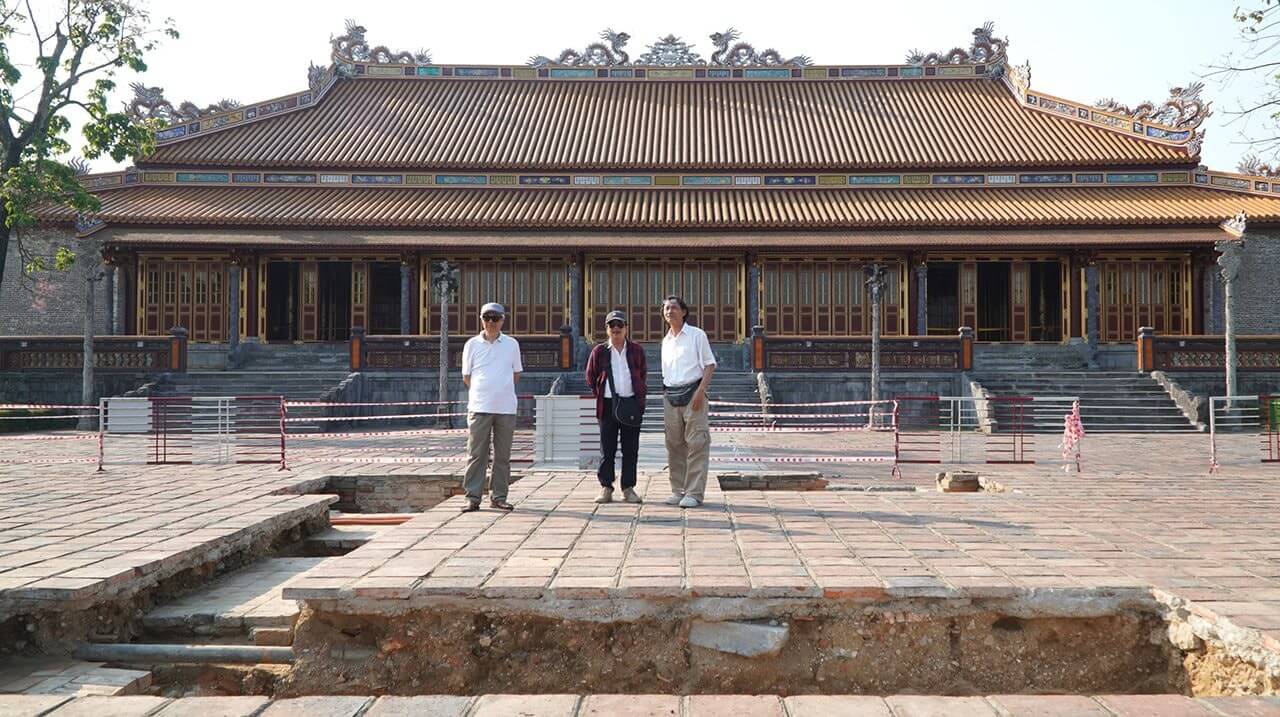
3.3.2. Left Vu and Right Vu
The two rows of buildings, Tả Vu and Hữu Vu, are located on either side of the dragon courtyard. They were once used as workplaces and reception areas for officials, court ladies, or court officials summoned to the palace. The architecture of the two rows of buildings is simple and symmetrical, creating a balanced layout within the space of the Imperial City of Hue.
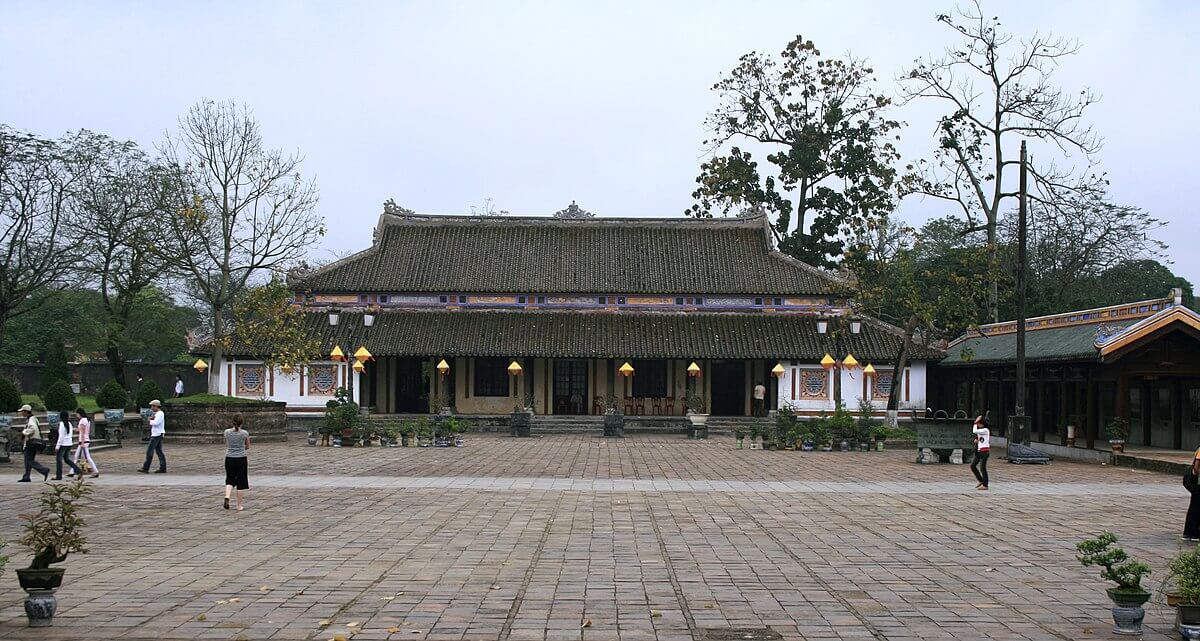
3.3.3. Can Chanh Power Plant
The Can Chanh Palace was where the king worked daily, received his ministers, and handled state affairs. It was the administrative center within the Imperial City of Hue. Although most of the structure was damaged during the war, the remaining traces reveal the sophistication of its layout and the crucial role of this area.
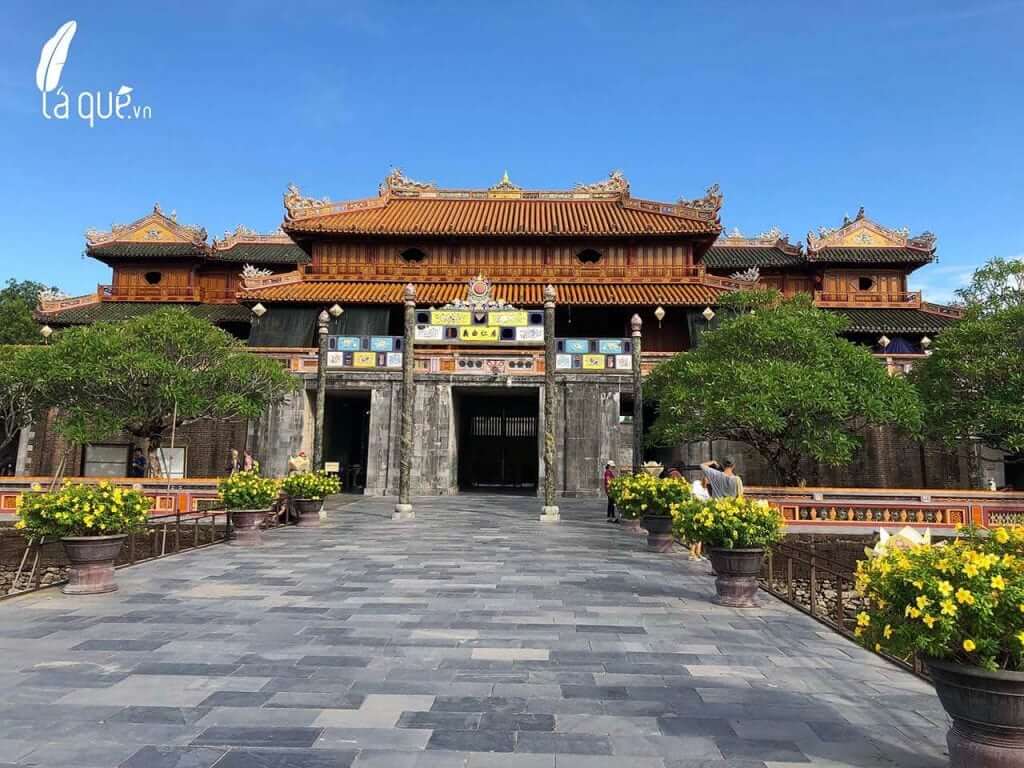
3.3.4. Thai Binh Lau and Thuong Uyen Garden
Thai Binh Lau was where the king read books, rested, and meditated. This is one of the few structures still intact in the Imperial City of Hue, featuring a two-story wooden structure, glazed tile roof, and exquisitely carved interior. Combined with the surrounding lush Thượng Uyển Garden, this area offers a sense of tranquility, poetry, and elegance—true to the spiritual life of royalty.
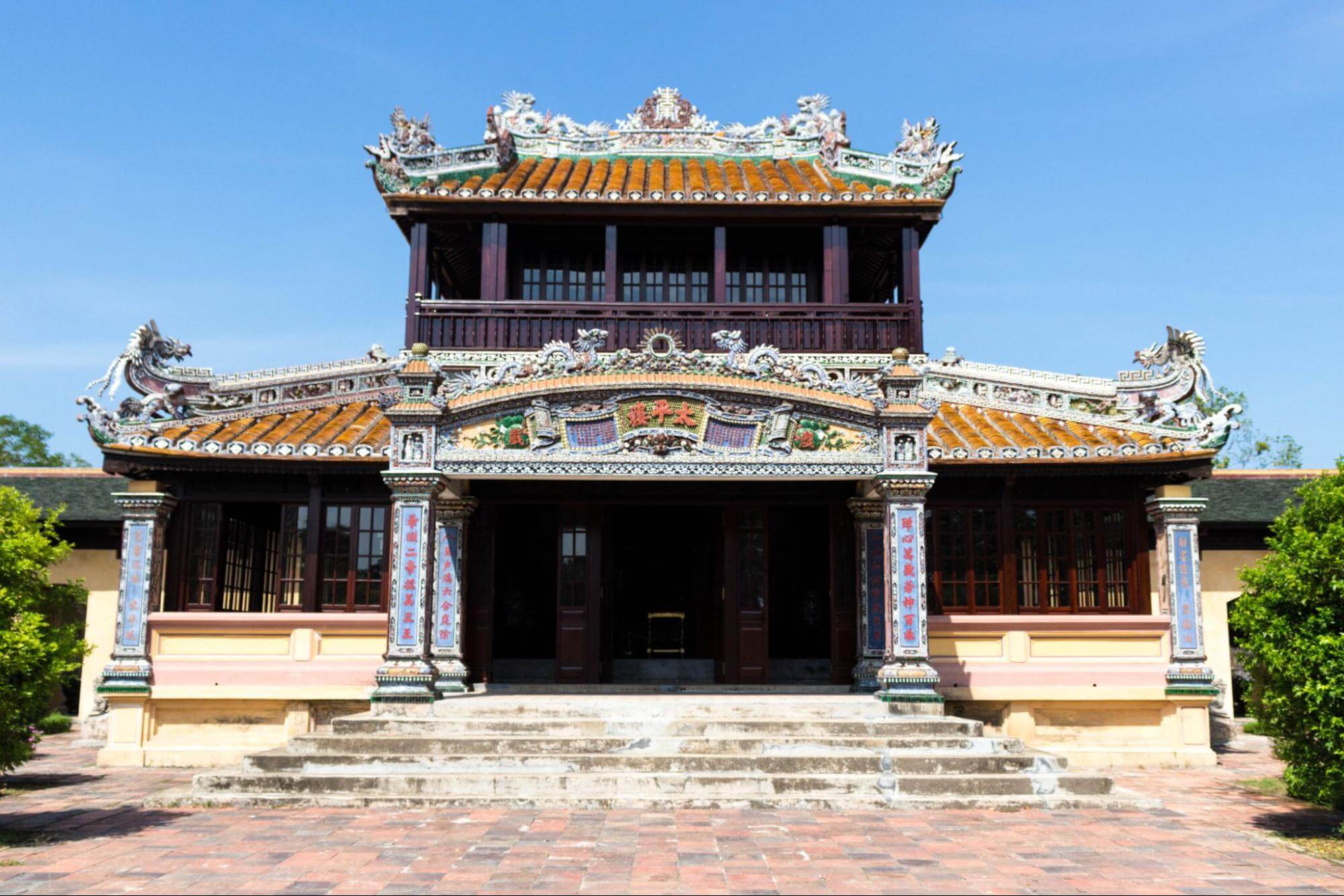
3.3.5. Dien Kien Trung
Kien Trung Power Plant It is the last palace built in the Imperial City (during the reign of King Khai Dinh), featuring a blend of Eastern and Western styles. The architecture incorporates many arched doors, balconies, and flat roofs combined with modern ceramic tiles. Kien Trung Palace reflects the period of modern cultural convergence and is a unique highlight in the entire ancient architectural complex.
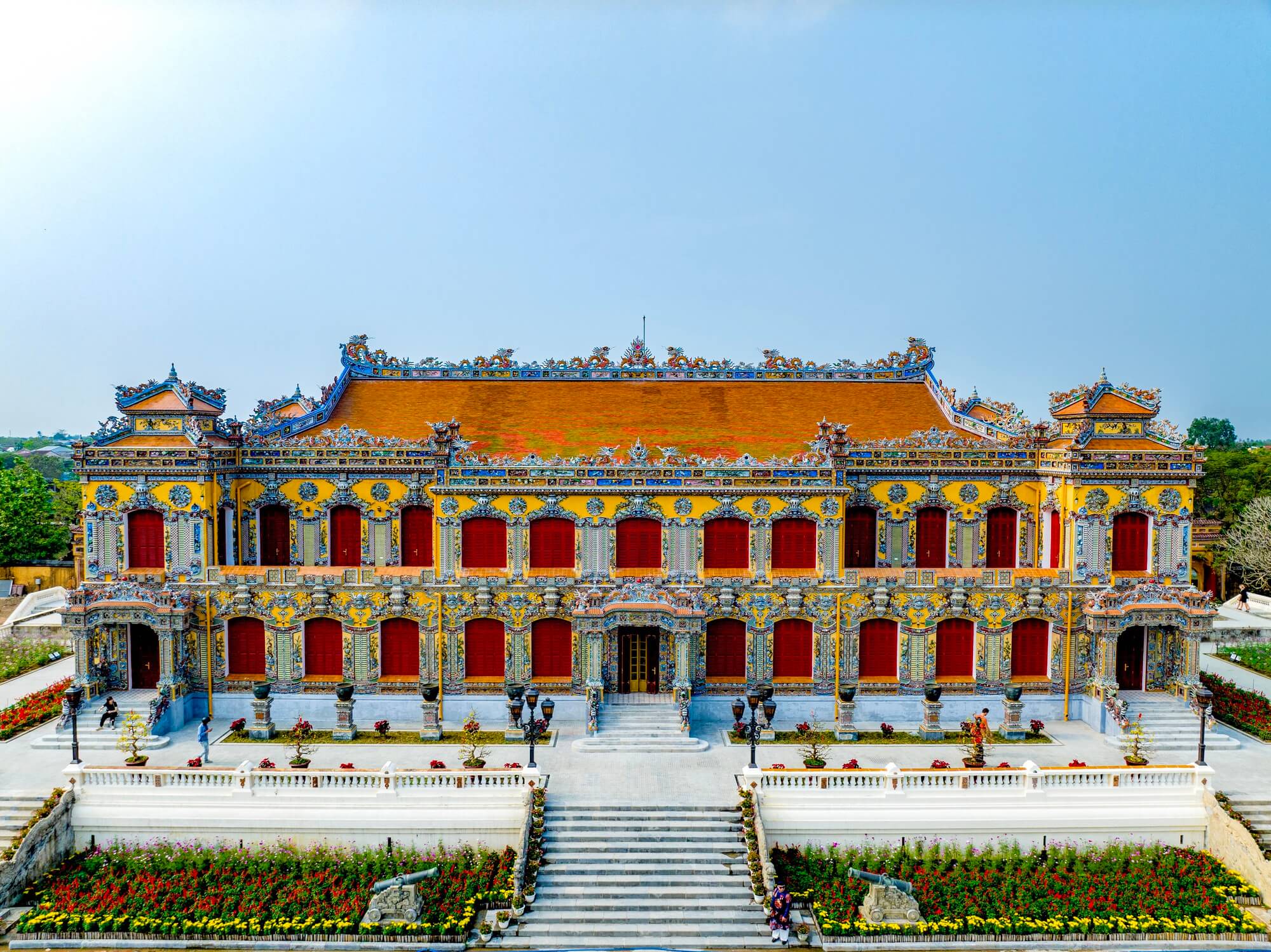
4. Top 10 experiences you must try on your trip The Imperial City of Hue add completely
4.1. Become royalty with our royal costume rental service
One of the most popular activities for tourists visiting the Imperial City is renting royal court attire and taking photos in the ancient setting of the imperial palace. From the robes of kings and queens to the costumes of officials and court ladies—all are meticulously designed, allowing you to relive the atmosphere of the royal court of old. These will surely be unforgettable souvenir photos from your journey exploring the ancient capital.
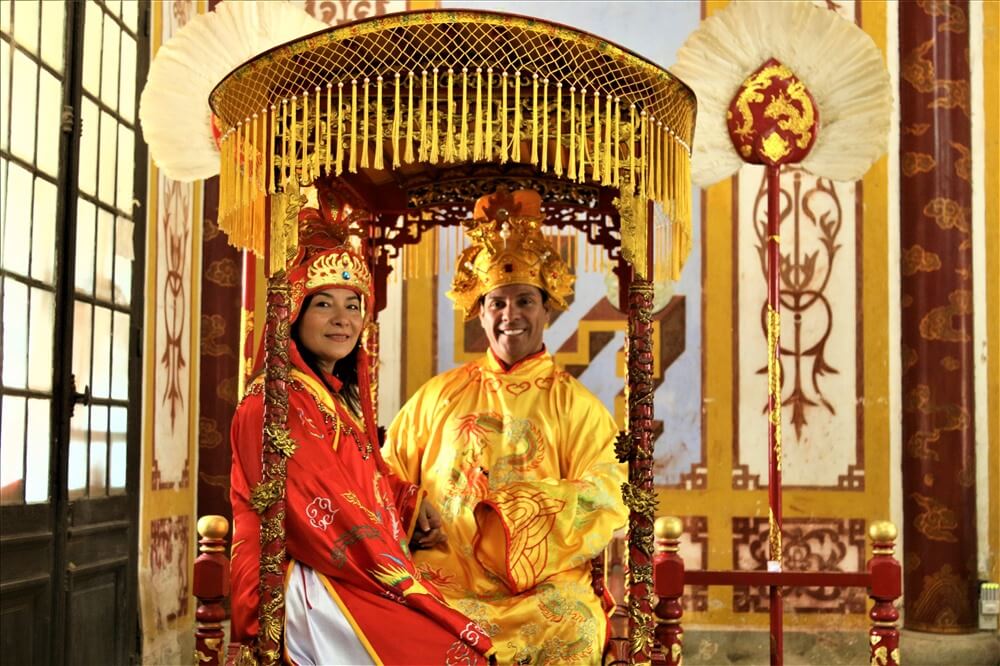
4.2. Watch the solemn Changing of the Guard ceremony at Ngọ Môn Gate
The changing of the guard ceremony at Ngo Mon Gate is reenacted based on the ancient Nguyen dynasty ritual, taking place daily at fixed times. Visitors will witness the parade and the solemn changing of the guard by soldiers dressed in court uniforms, creating a sacred atmosphere that feels like stepping back in time. It is recommended to arrive 5–10 minutes early to get the best viewing spot.

4.3. Admire the enchanting, mystical Imperial City of Hue at night
While the Imperial City exudes a solemn, ancient charm by day, at night it takes on a completely different appearance—sparkling with lights, mystical and romantic. The palaces and city gates are artfully illuminated, combined with soft sounds that recreate the atmosphere of the royal palace. This is a wonderful opportunity to experience a poetic and mysterious Hue.
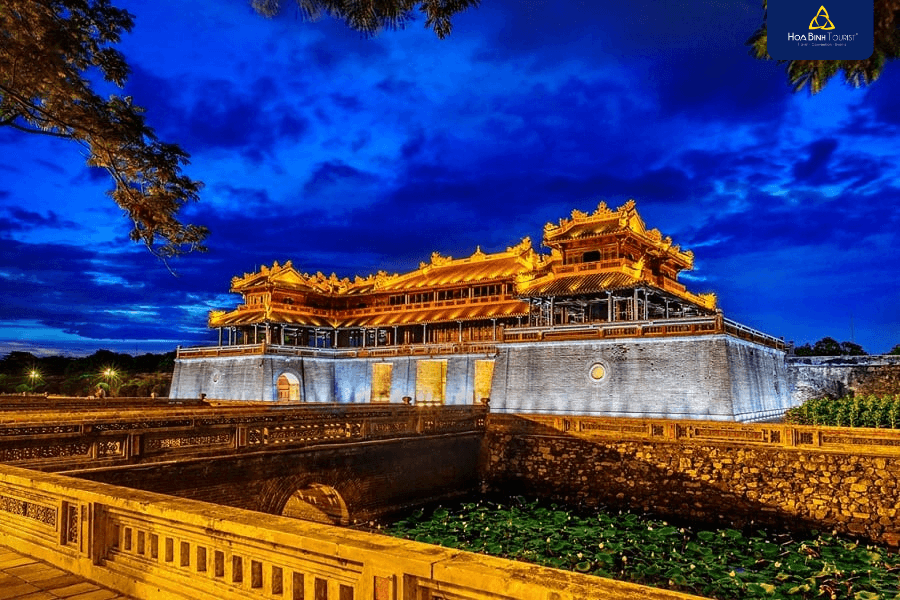
4.4. Enjoy Royal Afternoon Tea in the Dien Tho Palace
What could be better than sitting down to enjoy tea and traditional cakes in the ancient space of Dien Tho Palace, once the residence of the Empress Dowager? Some service providers here organize royal tea parties in the old style, allowing you to relax and experience the elegance of court life. The quiet, airy space is ideal for those who want to enjoy the tranquil beauty of Hue.
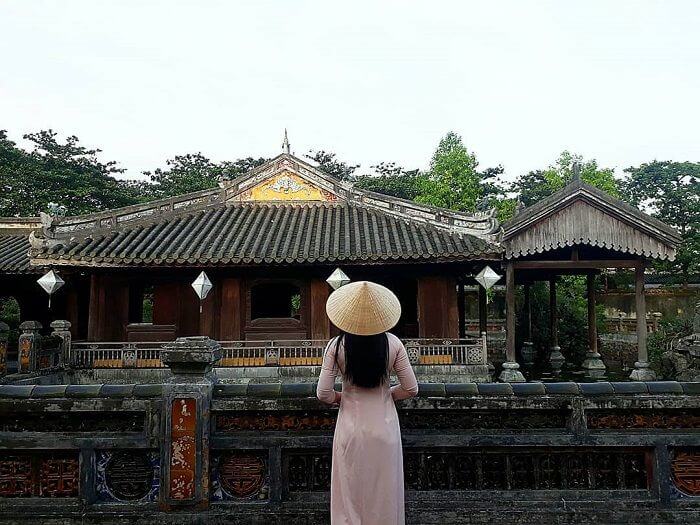
4.5. Take a cyclo ride around the Imperial City and listen to stories of the past
Experience a leisurely cyclo ride through the city gates, ancient corridors, and vast courtyards. Not only does it give your feet a rest, but it also gives you the opportunity to listen to stories of kings, queens, and rituals told by local cyclo drivers. This is a quintessential Hue experience, both relaxing and rich in cultural value.

4.6. Enjoy court music at Duyet Thi Duong Theater
Hue Court Music – recognized by UNESCO as an intangible cultural heritage – is the essence of Nguyen Dynasty music. At Duyet Thi Duong Theater, you can enjoy meticulously reconstructed performances that recreate the atmosphere of the ancient royal court through music, costumes, dance, and rituals. An unmissable artistic experience for those who love traditional culture.

4.7. Participate in unique royal court festival activities
If you visit Hue during the Hue Festival (held every two years or during traditional festivals), the Imperial City will host a series of special activities such as the Nam Giao altar ceremony, the royal decree procession, a reenactment of the royal wedding parade, martial arts performances, and traditional handicraft demonstrations. This is a golden opportunity for you to witness and immerse yourself in the unique royal festival atmosphere that can only be found in Hue.
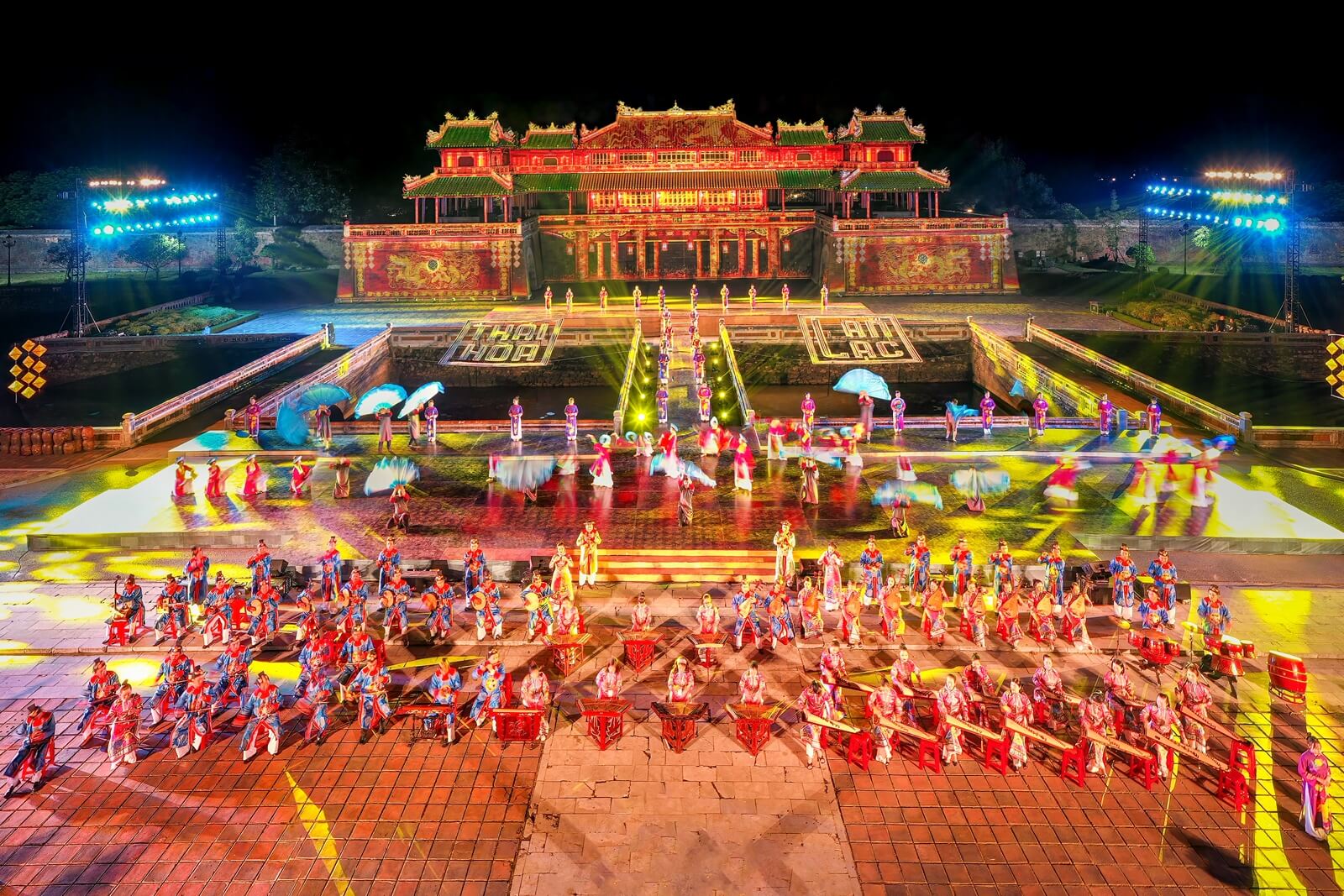
4.8. Visit the tombs of kings and queens within the historical site complex
In addition to the Imperial City, visitors should not miss mausoleum system of the Nguyen dynasty kings, such as the tombs of Tu Duc, Minh Mang, and Khai Dinh. Each tomb bears its own architectural and philosophical mark, ranging from romantic and close to nature to majestic and modern.
Ticket prices for the Imperial City of Hue, including the royal tombs, are listed below for tourists' reference:
| LOCATION | ADULT | CHILDREN (7-12 YEARS OLD) | CHILDREN <6 YEARS OLD |
| The Imperial City of Hue (Imperial Citadel + Forbidden City) | 200,000 VND | 40,000 VND | Free |
| Minh Mang Mausoleum | 150,000 VND | 30,000 VND | Free |
| Tu Duc Mausoleum | 150,000 VND | 30,000 VND | Free |
| Khai Dinh Mausoleum | 150,000 VND | 30,000 VND | Free |
| Gia Long Mausoleum | 150,000 VND | Free | Free |
| Dong Khanh Mausoleum | 150,000 VND | Free | Free |
| Duc Duc Mausoleum | 50,000 VND | Free | Free |
In addition, visitors can check the admission prices. The Imperial City of Hue when combined with the tombs:
| LOCATION | ADULT | CHILDREN (7-12 YEARS OLD) | CHILDREN <6 YEARS OLD |
| Route 03: Hue Imperial City – Minh Mang Tomb – Khai Dinh Tomb | $420 | $80 | Free |
| Route 03: Hue Imperial City – Tomb of Emperor Tu Duc – Tomb of Emperor Khai Dinh | $420 | $80 | Free |
| Route 04 stops: Hue Imperial City– Tomb of Emperor Minh Mang – Tomb of Emperor Tu Duc – Tomb of Emperor Khai Dinh | $30 USD | 100,000 VND | Free |
4.9. Learn about traditional crafts at the exhibition areas
Within the Imperial City grounds, there are exhibition areas showcasing traditional royal crafts such as bronze casting, hat making, Zèng weaving, royal robe embroidery, and carving. Visitors can not only observe the processes firsthand but also try their hand at making these crafts or purchase exquisite handmade items as souvenirs.
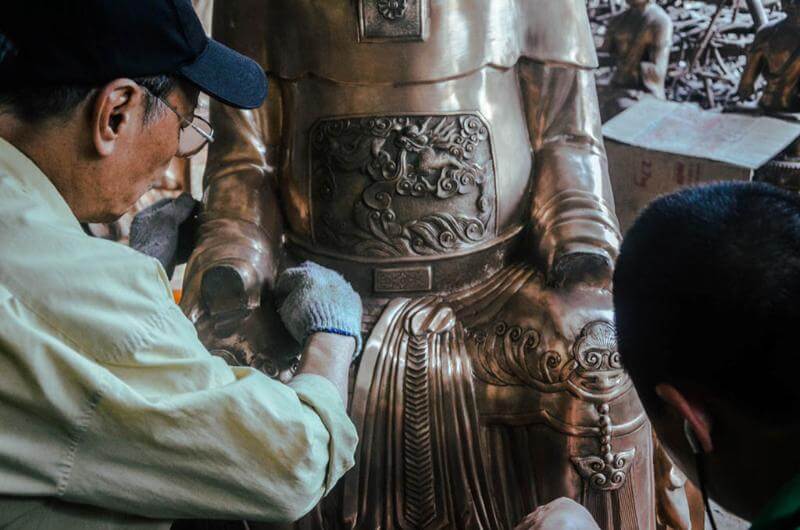
5. Pocket Guide to Conquering Hue Imperial City from A to Z
Whether it's your first time in Hue or you've been here before, a little preparation before exploring the Imperial City will help you save time, conserve energy, and have a smoother experience.
5.1. When is the ideal time to visit the Imperial City?
Hue is beautiful all year round, but the ideal time to visit the Imperial City is in spring (January–March) and late autumn (September–November). At this time, the weather is cool, there is little rain, and the light is soft – perfect for walking, taking photos, and exploring the imperial architecture.
Morning (7:00–9:00 a.m.) is the best time to visit, as it avoids the intense heat and there are fewer tourists. If you go in the afternoon, you should arrive before 3:00 p.m. to have enough time to enjoy the experience before closing time (5:00 p.m.).
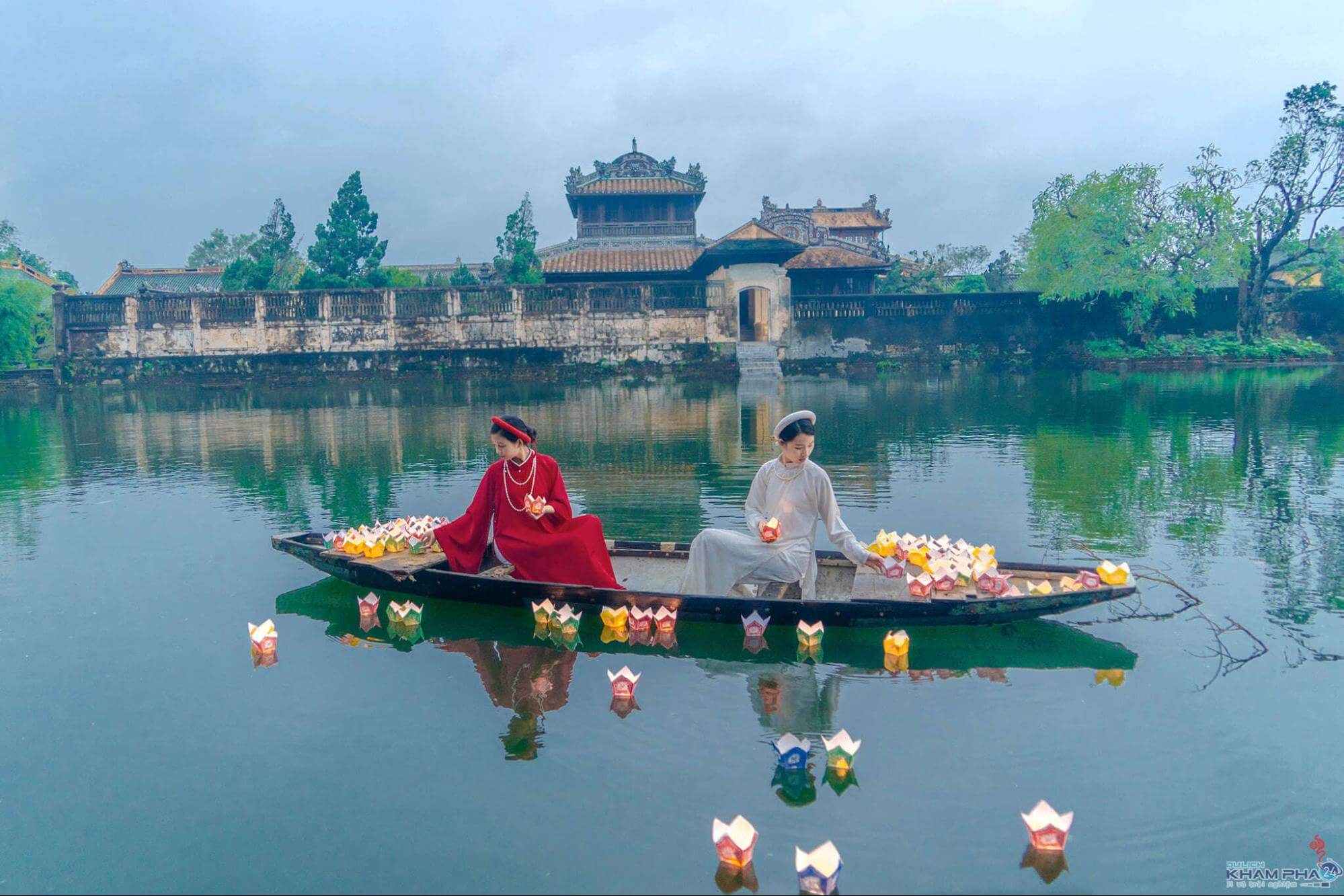
5.2. Detailed travel guide to Hue and within the Imperial City
For those departing from Hanoi, Da Nang, or Hoi An, Queen Cafe Bus is a sophisticated choice to begin your journey to Hue. The comfortable limousine, with its private cabin, will provide you with moments of relaxation on the road. A special feature is that the car takes you directly to the center of Hue at 7 Doi Cung, very close to Trang Tien Bridge, helping you easily check into your hotel and start your trip with a relaxed and calm mindset.
To help you easily plan and budget for your trip, below is a reference price list for Queen Cafe Bus's main routes to Hue:
| BUS ROUTE TO HUẾ | PRICE | BOOK TICKETS |
| Hanoi ⇔ Hue | $15.00 – $22.50 | Place it here |
| Da Nang ⇔ Hue | $150 | Place it here |
| Hoi An ⇔ Hue | $150 | Place it here |
| Ninh Binh ⇔ Hue | $150 - $200 | Place it here |
| Quang Binh ⇔ Hue | $180 | Place it here |
📞 For attentive consultation and the fastest ticket booking, you can contact:
- Hotline: 0906.413.468 – 0914.215.809
- Zalo: 0905.746.884 – 0914.215.809
- Website: https://queenbus.com.vn/
- Fanpage: Queen Cafe Open Bus
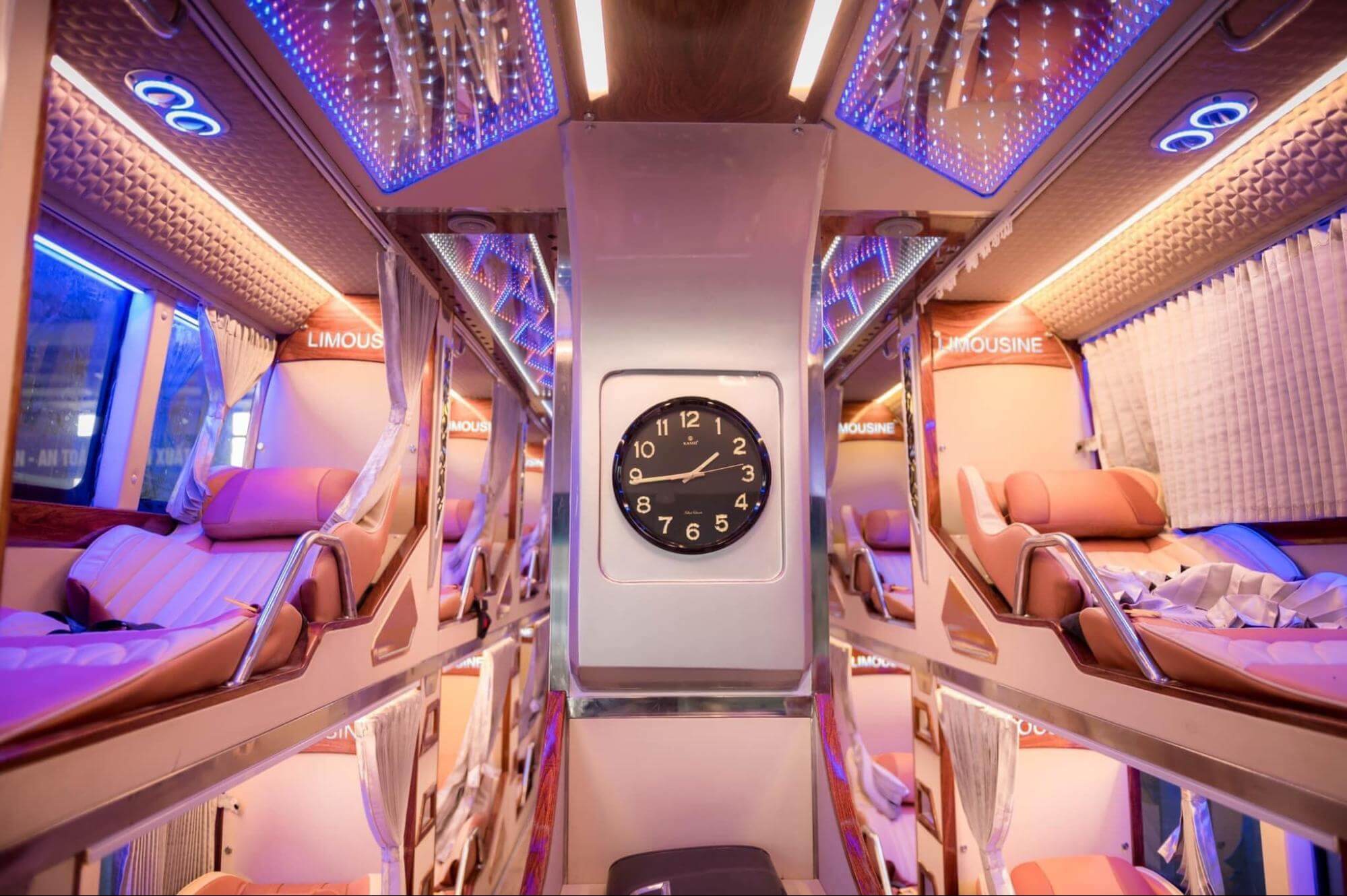
Within Hue city center, you can choose between a cyclo, a rental bicycle, or walking if you are staying near the Imperial City. Traveling by Grab or taxi is also very common.
5.3. Suggested itinerary for visiting the Imperial City of Hue (2 hours – Half day)
If you have two hours, prioritize the following tour route:
Ngọ Môn → Thái Hòa Palace → Thế Miếu → Cửu Đỉnh → Forbidden City (Đại Cung Môn, Cần Chánh Palace) → Thái Bình Lâu.

If you have half a day (~3–4 hours), you should add in places like:
Visit Dien Tho Palace, Truong Sanh Palace, Duyet Thi Duong, and enjoy royal tea or watch court music if you have time.
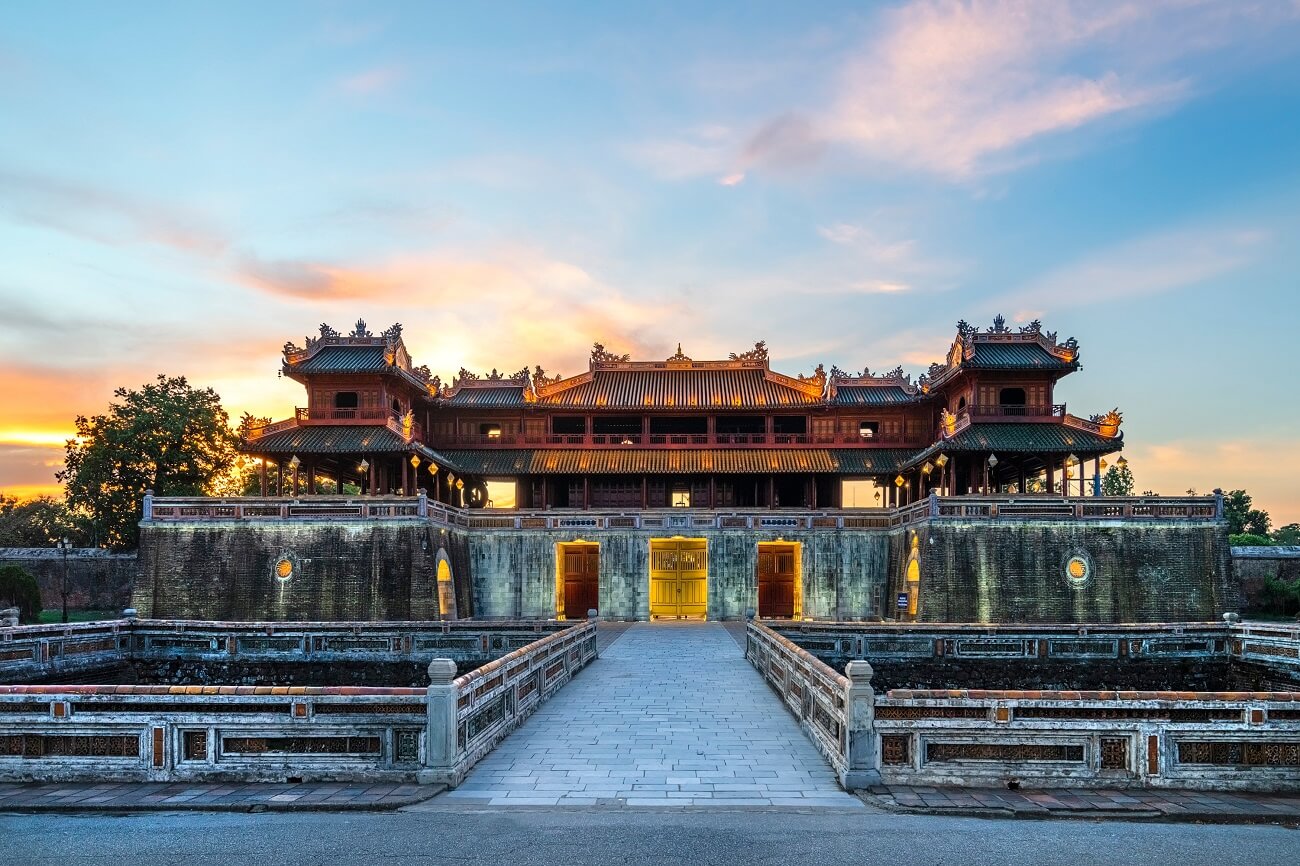
5.4. Some regulations when visiting the Imperial City of Hue
To visit the Imperial City of Hue, visitors must comply with the following regulations:
- Dress modestly and appropriately, avoiding short skirts or tank tops when entering the temple.
- Do not litter, vandalize, or climb on historical sites.
- Do not film commercially or use a drone without prior permission.
- Follow the instructions of security guards and signs within the historical site.
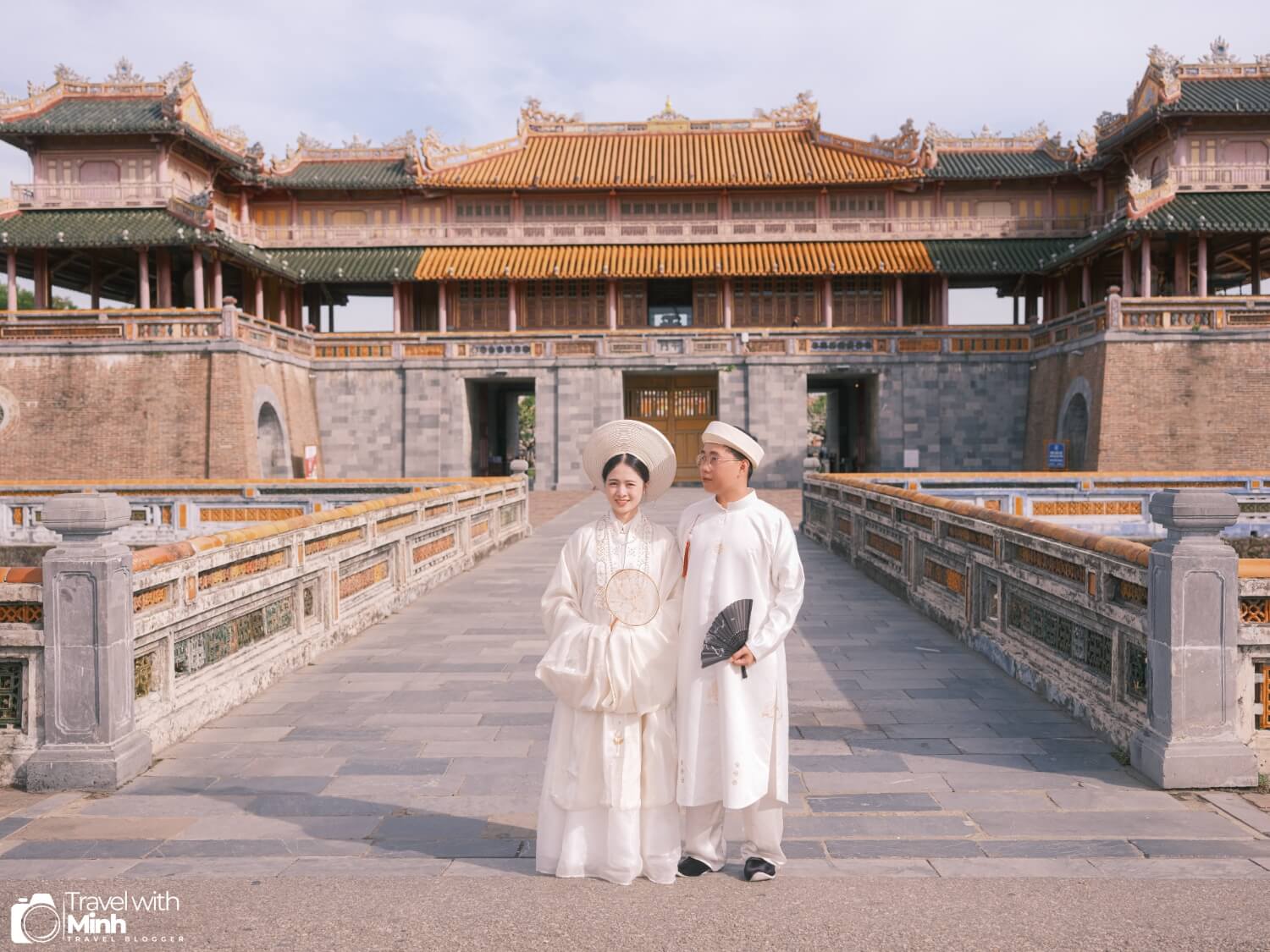
6. What to eat near the Imperial City of Hue? A Culinary Guide from the Palace to the Streets
6.1. Top restaurants serving authentic royal cuisine
Huế royal cuisine is not just about eating and drinking, but an art of living deeply rooted in the culture of the Nguyễn dynasty: elaborate, refined, and steeped in ritual. If you want to experience royal-style cuisine, here are some places worth trying:
6.1.1 Tinh Gia Vien – Imperial cuisine in the heart of the old town
- Address: 7/28 Le Thanh Ton Street, Thuan Thanh Ward, Hue City (very close to the Imperial City)
- Reference price: 250,000 – 600,000 VND per serving
- Special feature:
- The owner is a descendant of royalty, and the space is decorated like a miniature imperial garden.
- The menu recreates the royal banquet with over 10–12 dishes, served in blue-glazed porcelain bowls and plates modeled after Nguyen Dynasty ceramics.
- Featured dishes: Chả phụng, spring roll, phoenix porridge, lotus rice, 9 types of royal court tea.
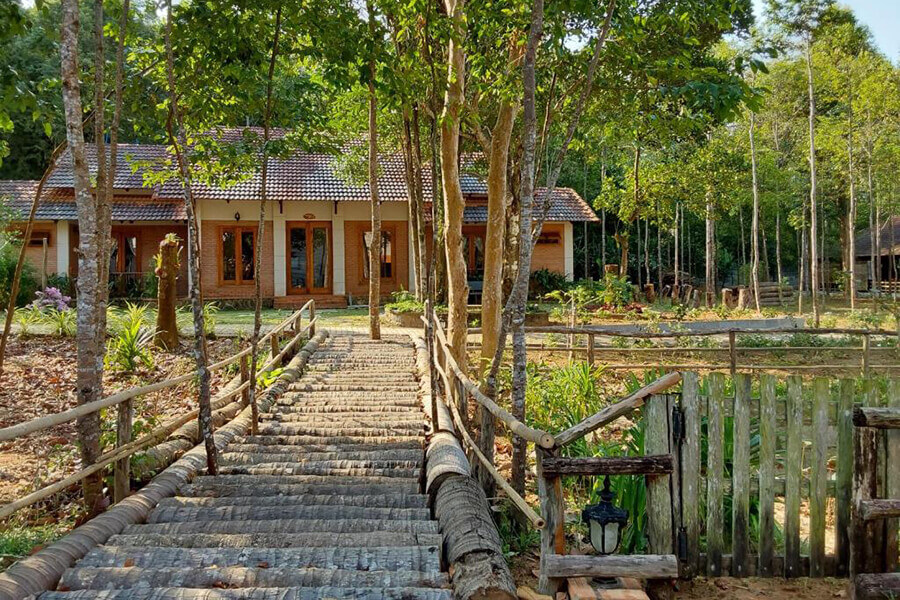
6.1.2 Cung Dinh Restaurant
- Address: 3 Nguyen Sinh Sac, Hue City
- Reference price: 300,000 – 800,000 VND per person (set menu available)
- Space: Traditional wooden houses, spacious gardens, staff wearing traditional long dresses, serving according to royal court etiquette.
- Special: Customers can place orders court music performance Combine in meals if traveling in groups of 6 or more people.
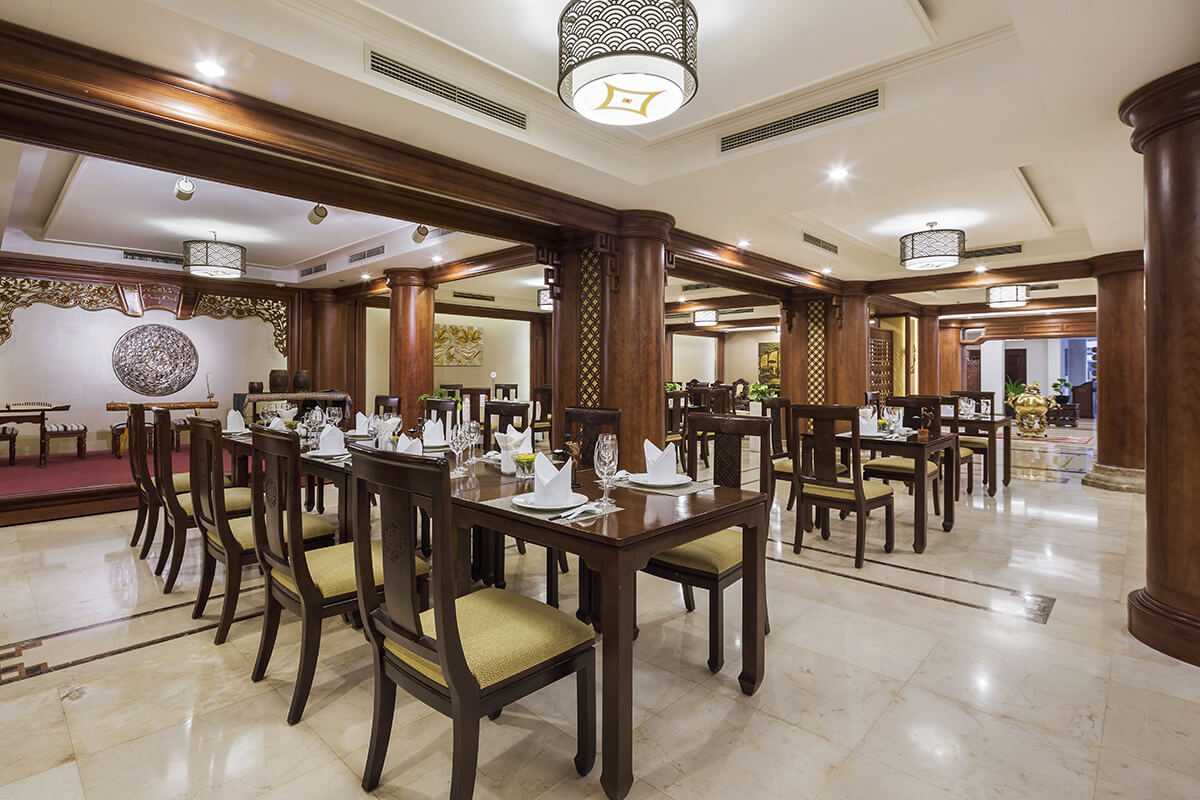
6.1.3 Ancient Hue Garden Houses
- Address: 104/47 Kim Long, about 2.5 km from the Imperial City
- Style: It is both a restaurant and a cultural space restored in the style of an old mansion.
- Cuisine: A combination of royal court cuisine and high-end traditional Hue cuisine
- Suitable: For couples and families seeking a quiet, luxurious place.

6.2. Suggestions for delicious, nutritious, and affordable Hue specialty restaurants in the area
No need to be overly elaborate—simple, rustic dishes define the distinctive character of Hue cuisine. You can easily find quality eateries with reasonable prices just a few steps away from the Imperial City of Hue:
6.2.1 Shops on Doan Thi Diem Street – Nguyen Trai Street – Le Huan Street
- This is a "street food market" located next to the Imperial City, with many street vendors and small restaurants selling a variety of typical Hue dishes:
- Bánh bèo – bánh nậm – bánh lọc: 10,000 – 25,000 VND per portion
- Hue beef noodles: 25,000 – 40,000 VND per bowl
Rice with clams – noodles with clams: spicy, rich, only 15,000 – 20,000 VND per serving
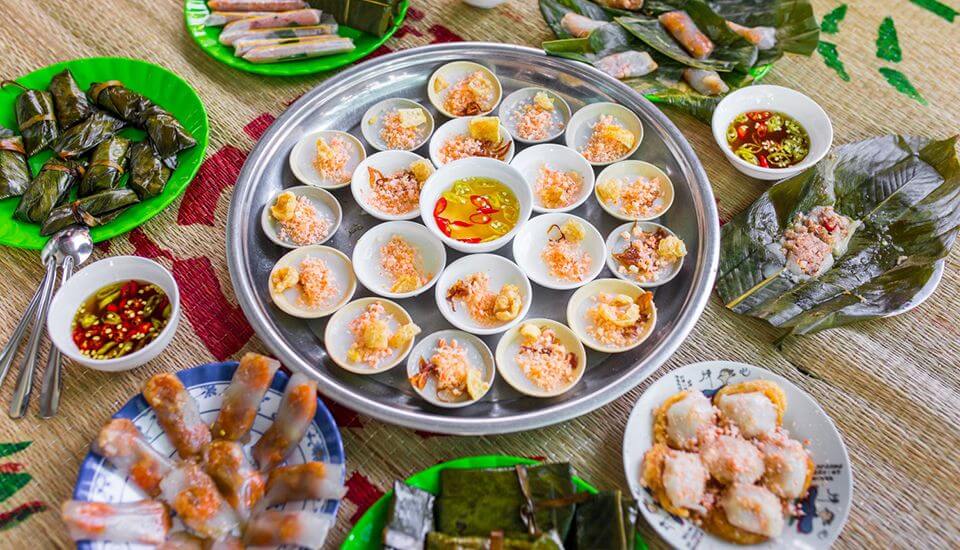
6.2.2 East Sea Clam Rice
- Address: 64 Kiet 7 Ung Binh, near Gia Hoi Bridge
- Specialty: Rice with clams, noodles with clams, porridge with clams, just like the people of Hue used to make them – salty, slightly spicy, served with pork rinds, fresh herbs, and hot clam broth.
- Price: only 10,000 – 20,000 VND
- A rustic, down-to-earth space that's always packed with locals – a sign that it's "just right."
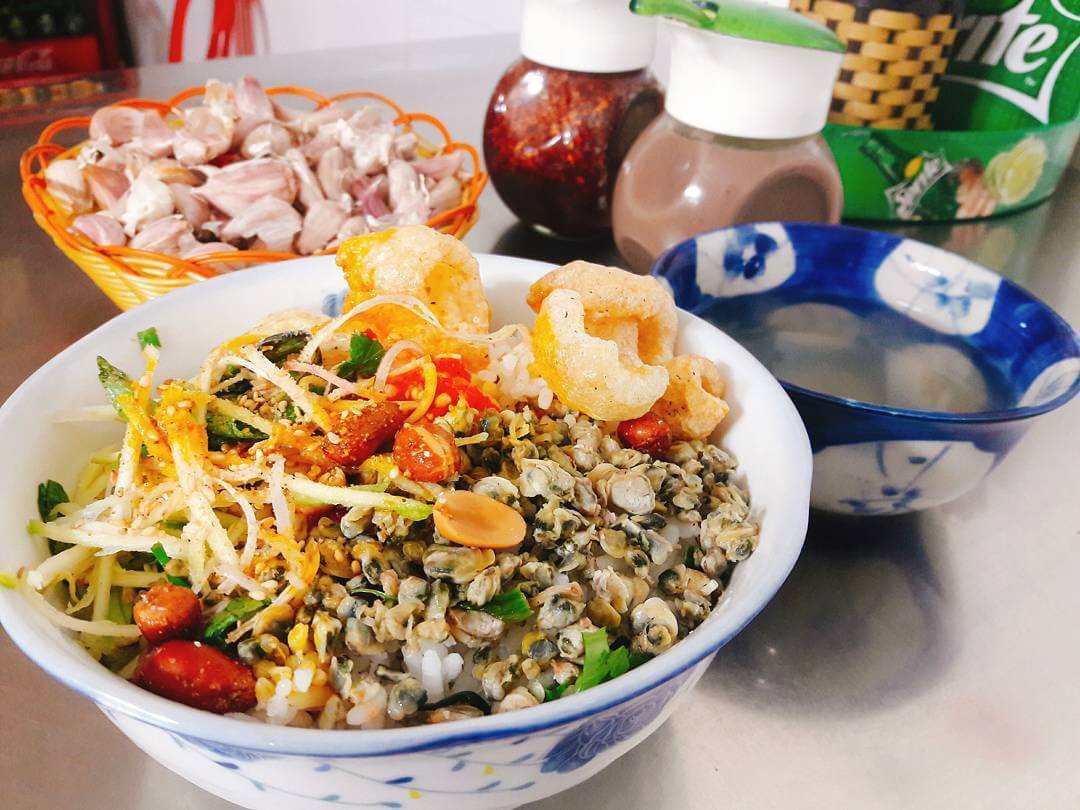
6.2.3 Mệ Kéo Restaurant
- Address: 20 Bach Dang Street, near Dong Ba Market
- Special feature:
- The restaurant has been around for nearly 80 years, opened by an elderly woman during the French colonial period.
- Soft and smooth rice cakes with a rich shrimp filling, served with authentic Hue-style fish sauce.
- Price: Approximately 15,000 – 25,000 VND per tray of cakes
- Small space, but always cozy and full of Hue charm.
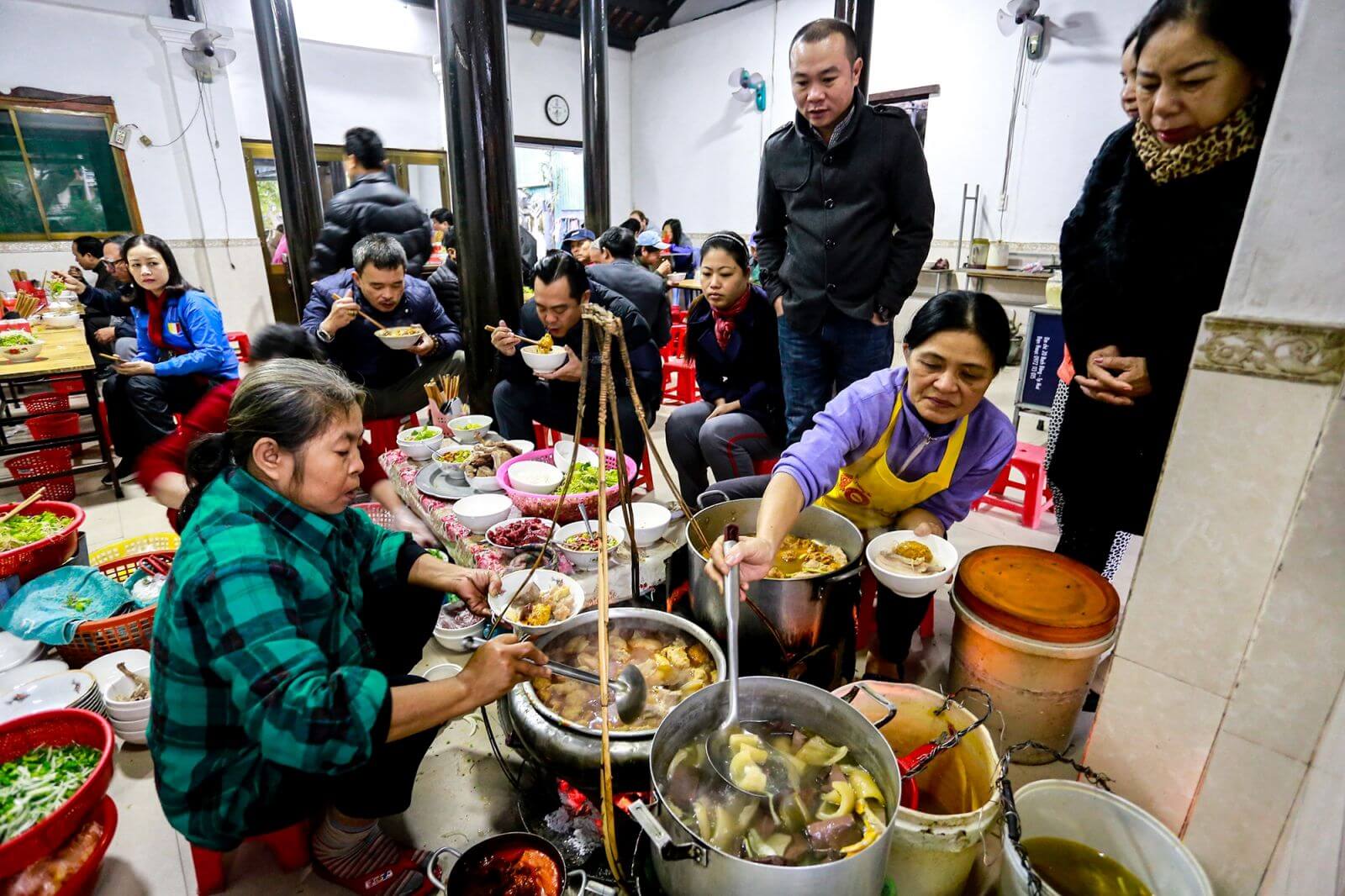
Frequently Asked Questions
Hire a local tour guide at the entrance.
Or use an audio guide with headphones, available in multiple languages.
Buy directly at the Ngo Mon Gate ticket counter.
Or book in advance via the Hue Monuments Conservation Center website to avoid queues.


